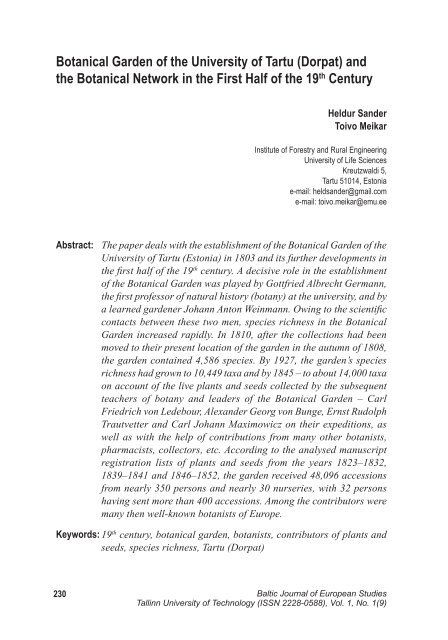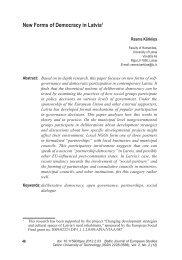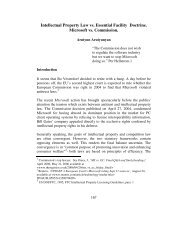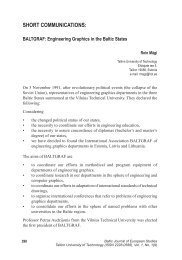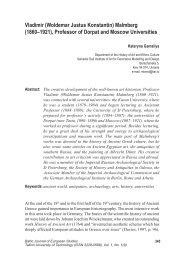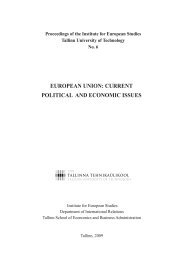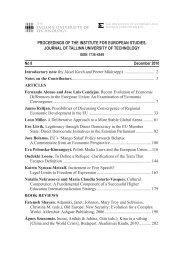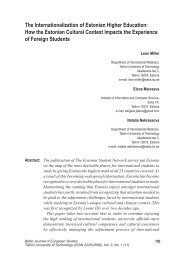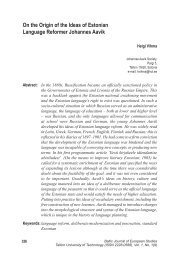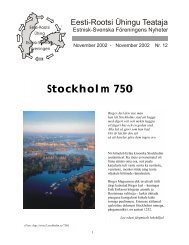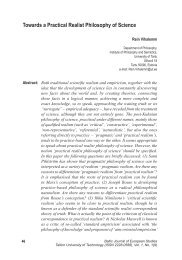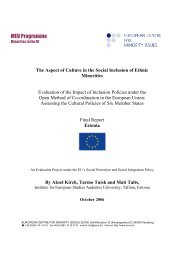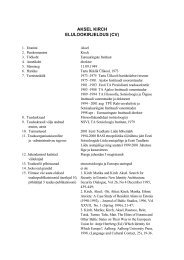Botanical Garden of the university of tartu (dorpat) - The Institute for ...
Botanical Garden of the university of tartu (dorpat) - The Institute for ...
Botanical Garden of the university of tartu (dorpat) - The Institute for ...
You also want an ePaper? Increase the reach of your titles
YUMPU automatically turns print PDFs into web optimized ePapers that Google loves.
Heldur Sander, Toivo Meikar<br />
<strong>Botanical</strong> <strong>Garden</strong> <strong>of</strong> <strong>the</strong> University <strong>of</strong> Tartu (Dorpat) and<br />
<strong>the</strong> <strong>Botanical</strong> Network in <strong>the</strong> First Half <strong>of</strong> <strong>the</strong> 19 th Century<br />
Heldur Sander<br />
Toivo Meikar<br />
<strong>Institute</strong> <strong>of</strong> Forestry and Rural Engineering<br />
University <strong>of</strong> Life Sciences<br />
Kreutzwaldi 5,<br />
Tartu 51014, Estonia<br />
e-mail: heldsander@gmail.com<br />
e-mail: toivo.meikar@emu.ee<br />
Abstract: <strong>The</strong> paper deals with <strong>the</strong> establishment <strong>of</strong> <strong>the</strong> <strong>Botanical</strong> <strong>Garden</strong> <strong>of</strong> <strong>the</strong><br />
University <strong>of</strong> Tartu (Estonia) in 1803 and its fur<strong>the</strong>r developments in<br />
<strong>the</strong> first half <strong>of</strong> <strong>the</strong> 19 th century. A decisive role in <strong>the</strong> establishment<br />
<strong>of</strong> <strong>the</strong> <strong>Botanical</strong> <strong>Garden</strong> was played by Gottfried Albrecht Germann,<br />
<strong>the</strong> first pr<strong>of</strong>essor <strong>of</strong> natural history (botany) at <strong>the</strong> <strong>university</strong>, and by<br />
a learned gardener Johann Anton Weinmann. Owing to <strong>the</strong> scientific<br />
contacts between <strong>the</strong>se two men, species richness in <strong>the</strong> <strong>Botanical</strong><br />
<strong>Garden</strong> increased rapidly. In 1810, after <strong>the</strong> collections had been<br />
moved to <strong>the</strong>ir present location <strong>of</strong> <strong>the</strong> garden in <strong>the</strong> autumn <strong>of</strong> 1808,<br />
<strong>the</strong> garden contained 4,586 species. By 1927, <strong>the</strong> garden’s species<br />
richness had grown to 10,449 taxa and by 1845 – to about 14,000 taxa<br />
on account <strong>of</strong> <strong>the</strong> live plants and seeds collected by <strong>the</strong> subsequent<br />
teachers <strong>of</strong> botany and leaders <strong>of</strong> <strong>the</strong> <strong>Botanical</strong> <strong>Garden</strong> – Carl<br />
Friedrich von Ledebour, Alexander Georg von Bunge, Ernst Rudolph<br />
Trautvetter and Carl Johann Maximowicz on <strong>the</strong>ir expeditions, as<br />
well as with <strong>the</strong> help <strong>of</strong> contributions from many o<strong>the</strong>r botanists,<br />
pharmacists, collectors, etc. According to <strong>the</strong> analysed manuscript<br />
registration lists <strong>of</strong> plants and seeds from <strong>the</strong> years 1823–1832,<br />
1839–1841 and 1846–1852, <strong>the</strong> garden received 48,096 accessions<br />
from nearly 350 persons and nearly 30 nurseries, with 32 persons<br />
having sent more than 400 accessions. Among <strong>the</strong> contributors were<br />
many <strong>the</strong>n well-known botanists <strong>of</strong> Europe.<br />
Keywords: 19 th century, botanical garden, botanists, contributors <strong>of</strong> plants and<br />
seeds, species richness, Tartu (Dorpat)<br />
230<br />
Baltic Journal <strong>of</strong> European Studies<br />
Tallinn University <strong>of</strong> Technology (ISSN 2228-0588), Vol. 1, No. 1(9)
<strong>Botanical</strong> <strong>Garden</strong> <strong>of</strong> <strong>the</strong> University <strong>of</strong> Tartu (Dorpat) and<br />
<strong>the</strong> <strong>Botanical</strong> Network in <strong>the</strong> First Half <strong>of</strong> <strong>the</strong> 19 th Century<br />
Introduction<br />
By <strong>the</strong> end <strong>of</strong> <strong>the</strong> 18 th century, a solid botanical network had emerged in Europe,<br />
involving many researchers and amateur naturalists, academic plant taxonomic<br />
research and publishing at universities, numerous extensive expeditions,<br />
botanical gardens, private collections, nurseries and developments in ornamental<br />
gardening. Great numbers <strong>of</strong> plants had been collected in botanical and private<br />
gardens, herbaria had been established, many local and <strong>for</strong>eign floras had been<br />
examined and an extensive botanical bibliography published (Pritzel, 1851, pp.<br />
1–330, 379–391; Meyer, 1857, pp. 254–288; Hill, 1915, pp. 190–223).<br />
<strong>Botanical</strong> science in Russia in <strong>the</strong> 18 th and 19 th century was advanced largely<br />
by natural scientists educated in Germany, France, England, Denmark and<br />
Sweden, who had settled in Russia in <strong>the</strong> 18 th century <strong>for</strong> <strong>the</strong>ir research and <strong>for</strong><br />
arranging research expeditions. At <strong>the</strong> same time, researchers also emerged from<br />
among <strong>the</strong> Baltic Germans. All <strong>the</strong>se researchers published also <strong>the</strong>ir numerous<br />
scientific works in Germany and Russia (Trautvetter, 1837, pp. 4–50, 57–75;<br />
Kolchinsky, 2004, pp. 106–116; Sokol<strong>of</strong>f et al., 2002, pp. 129–191). Thirty-six<br />
better-known botanical gardens with various purposes and names are mentioned<br />
in Russia from <strong>the</strong> 17 th century onward (Trautvetter, 1837, pp. 51–54). Private<br />
gardens were actively established also in <strong>the</strong> provinces <strong>of</strong> Estonia and Livonia,<br />
and also <strong>the</strong> park culture here was highly developed (Hupel, 1791, pp. 534–553;<br />
Germann, 1805, pp. 17–32; Hein, 2007, pp. 15–87).<br />
<strong>The</strong> first private botanical gardens in Russia were established in <strong>the</strong> 18 th century<br />
in <strong>the</strong> manor <strong>of</strong> Demidov near <strong>the</strong> village <strong>of</strong> Krasnoe Solikamsk in <strong>the</strong> Urals<br />
(1731), in <strong>the</strong> Neskuchny Manor <strong>of</strong> Prokopy Demidov in Moscow (1756), and<br />
in <strong>the</strong> manor <strong>of</strong> Alexei Razumovsky at Gorenki (in <strong>the</strong> late 18 th century). In<br />
1771, Ivan Lepekhin registered 422 species in <strong>the</strong> garden <strong>of</strong> Solikamsk, several<br />
<strong>of</strong> <strong>the</strong>m being exotic species. <strong>The</strong> plant catalogue <strong>of</strong> <strong>the</strong> Neskuchny <strong>Garden</strong><br />
contained 2,000 species in 1781 and 4,363 species in 1806. <strong>The</strong> Gorenki <strong>Garden</strong><br />
was led in its early years by botanists Friedrich Christian Stephan (1798–1803),<br />
Ivan Redowsky (1803–1805), and Friedrich Ernst Ludwig von Fischer from<br />
Germany (since 1806), each <strong>of</strong> <strong>the</strong>m giving a contribution to increasing <strong>the</strong><br />
species richness <strong>of</strong> <strong>the</strong> garden. Owing to Fischer, seeds and plants were sent or<br />
brought <strong>the</strong>re by many Russian explorers. In 1803, <strong>the</strong> garden contained 2,846<br />
species, while <strong>the</strong> collection had increased to 8,036 species by 1812 (Trautvetter,<br />
1837, pp. 52–53; Sokol<strong>of</strong>f et al., 2002, pp. 161–169, 182–183; Elina, 2006, pp.<br />
582–583).<br />
Baltic Journal <strong>of</strong> European Studies<br />
Tallinn University <strong>of</strong> Technology (ISSN 2228-0588), Vol. 1, No. 1(9)<br />
231
Heldur Sander, Toivo Meikar<br />
By <strong>the</strong> time <strong>the</strong> <strong>Botanical</strong> <strong>Garden</strong> <strong>of</strong> <strong>the</strong> University <strong>of</strong> Tartu began to be established,<br />
botanical gardens had existed in Europe <strong>for</strong> 250 years and a large variety <strong>of</strong><br />
plants had been introduced <strong>the</strong>re from various regions <strong>of</strong> <strong>the</strong> world. In addition,<br />
good contacts had been established between <strong>the</strong> botanical gardens, botanists<br />
and explorers in Western Europe and Russia. Many researchers who had been<br />
educated in <strong>the</strong> universities <strong>of</strong> Europe had given a great contribution to studying<br />
<strong>the</strong> flora <strong>of</strong> Russia, and many plants were preserved in bigger collections and<br />
herbaria (Trautvetter, 1837, pp. 1–145; Sokol<strong>of</strong>f et al., 2002, pp. 129–191). All<br />
this contributed to <strong>the</strong> rapid <strong>for</strong>mation <strong>of</strong> species richness in <strong>the</strong> <strong>Botanical</strong> <strong>Garden</strong><br />
<strong>of</strong> <strong>the</strong> University <strong>of</strong> Tartu. New plants were obtained from many locations and <strong>the</strong><br />
garden evolved into one <strong>of</strong> <strong>the</strong> biggest and most significant botanical gardens in<br />
Russia in <strong>the</strong> 19 th century, first <strong>of</strong> all due to <strong>the</strong> diversity <strong>of</strong> plants from East Asia.<br />
This paper deals with <strong>the</strong> <strong>for</strong>mation and changes <strong>of</strong> species richness in <strong>the</strong><br />
<strong>Botanical</strong> <strong>Garden</strong> <strong>of</strong> <strong>the</strong> University <strong>of</strong> Tartu in 1804–1851, also providing an<br />
insight into <strong>the</strong> garden’s leading staff as well as <strong>the</strong> provenance and contributors<br />
<strong>of</strong> live plants and seeds in <strong>the</strong> above period.<br />
Methods and material<br />
<strong>The</strong> paper builds on published literature and on manuscripts preserved in <strong>the</strong><br />
Estonian Historical Archives in Tartu (EAA 1) – general plant lists <strong>of</strong>, and data<br />
on contributors <strong>of</strong> plants to, <strong>the</strong> <strong>Botanical</strong> <strong>Garden</strong> <strong>of</strong> <strong>the</strong> University <strong>of</strong> Tartu. <strong>The</strong><br />
general lists cover <strong>the</strong> years 1804, 1816–1818, 1822, 1823–1840, 1842, 1843,<br />
1846, 1848 and 1851. Two general lists are stored in <strong>the</strong> <strong>Botanical</strong> <strong>Garden</strong> <strong>of</strong> <strong>the</strong><br />
University <strong>of</strong> Tartu. One <strong>of</strong> <strong>the</strong>m is untitled and thus it remains unclear which<br />
data it concerns, while <strong>the</strong> o<strong>the</strong>r one is <strong>the</strong> general list <strong>for</strong> 1845 (Enumeratio...,<br />
1845). Both have been analysed be<strong>for</strong>e (Sander, 2010, pp. 90–93). <strong>The</strong> plant<br />
names occurring in <strong>the</strong> manuscripts are written in ink on <strong>the</strong> left-hand pages<br />
toge<strong>the</strong>r with <strong>the</strong> names <strong>of</strong> <strong>the</strong> species’ authors and <strong>of</strong>ten also with <strong>the</strong> names <strong>of</strong><br />
senders <strong>of</strong> <strong>the</strong> plants. In places, plant names in <strong>the</strong> manuscripts have been crossed<br />
out, recorded by numbers or just by <strong>the</strong> names <strong>of</strong> authors, and a few entries have<br />
also been added in between. <strong>The</strong> right-hand pages contain additional data, which<br />
are <strong>of</strong>ten written in pencil and appear to have been added later. <strong>The</strong> lists do not<br />
reveal <strong>the</strong>ir compilers – only in some single cases are <strong>the</strong>y signed and stamped<br />
by <strong>the</strong> <strong>the</strong>n directors <strong>of</strong> <strong>the</strong> garden.<br />
Also <strong>the</strong> registration lists <strong>of</strong> seeds or live plants sent to <strong>the</strong> botanical garden have<br />
been preserved from <strong>the</strong> first half <strong>of</strong> <strong>the</strong> 19 th century. <strong>The</strong>se contain <strong>the</strong> following<br />
232<br />
Baltic Journal <strong>of</strong> European Studies<br />
Tallinn University <strong>of</strong> Technology (ISSN 2228-0588), Vol. 1, No. 1(9)
<strong>Botanical</strong> <strong>Garden</strong> <strong>of</strong> <strong>the</strong> University <strong>of</strong> Tartu (Dorpat) and<br />
<strong>the</strong> <strong>Botanical</strong> Network in <strong>the</strong> First Half <strong>of</strong> <strong>the</strong> 19 th Century<br />
data: <strong>the</strong> name <strong>of</strong> <strong>the</strong> sender, place <strong>of</strong> dispatch, number <strong>of</strong> accessions received on<br />
<strong>the</strong> respective date, and <strong>the</strong> date <strong>of</strong> arrival or registration. <strong>The</strong> names <strong>of</strong> senders are<br />
missing in places. In most cases it is also mentioned whe<strong>the</strong>r <strong>the</strong> parcel contains<br />
seeds or live plants, although <strong>the</strong> latter were sent only in very rare cases. Also <strong>the</strong><br />
names <strong>of</strong> plants are listed. <strong>The</strong> lists cover <strong>the</strong> following periods: 23 Jan 1823–7<br />
Nov 1832, 10 Apr 1839–22 May 1841 and 12 May 1846–1854 (EAA 2).<br />
Leaders <strong>of</strong> <strong>the</strong> <strong>Botanical</strong> <strong>Garden</strong> <strong>of</strong> <strong>the</strong> University <strong>of</strong> Tartu<br />
In <strong>the</strong> first half <strong>of</strong> <strong>the</strong> 19 th century, <strong>the</strong> <strong>Botanical</strong> <strong>Garden</strong> <strong>of</strong> <strong>the</strong> University <strong>of</strong> Tartu<br />
had three directors: Gottfried Albrecht Germann (1803–1809), Carl Friedrich<br />
von Ledebour (1811–1836) and Alexander Georg von Bunge (1836–1867)<br />
(Siilivask, 1982, pp. 185–188). Next to <strong>the</strong> directors, a great contribution to <strong>the</strong><br />
development <strong>of</strong> <strong>the</strong> <strong>Botanical</strong> <strong>Garden</strong> was made by <strong>the</strong> assistant directors and<br />
learned gardeners (Meikar, 2002, pp. 61–73) (Table 1). <strong>The</strong> latter immediately<br />
started to lead <strong>the</strong> work in <strong>the</strong> garden and had a great impact on <strong>the</strong> actual<br />
situation in <strong>the</strong> garden.<br />
Table 1.<br />
Directors and learned gardeners <strong>of</strong> <strong>the</strong> <strong>Botanical</strong> <strong>Garden</strong> <strong>of</strong> <strong>the</strong> University <strong>of</strong><br />
Tartu in <strong>the</strong> first half <strong>of</strong> <strong>the</strong> 19 th century* (Meikar, 2002, p. 65)<br />
Directors Assistant directors Head gardeners<br />
Gottfried Albrecht<br />
Germann<br />
(1803–1809)<br />
Carl Christian<br />
Friedrich<br />
von Ledebour<br />
(1811–1836)<br />
Alexander Georg<br />
von Bunge<br />
(1836–1867)<br />
Ernst Rudolph Trautvetter<br />
(1833–1835)<br />
Carl Albert Rathlef (1835)<br />
Carl Herrmann Bluhm<br />
(1835–1836)<br />
Anton Bärnh<strong>of</strong>f (1836)<br />
Friedrich Julius Seetzen<br />
(1836–1846)<br />
Friedrich Wilhelm Kupffer<br />
(1848–1850)<br />
Carl Johann Maximowicz<br />
(1850–1852)<br />
* <strong>The</strong> table does not include short-term substitutes in <strong>the</strong>se positions.<br />
Johann Friedrich Kieser<br />
(1803–1804)<br />
Johann Peter Buek (1804)<br />
Johann Anton Weinmann<br />
(1805–1813)<br />
Albert Siegmund Natusch<br />
(1813–1814)<br />
Carl Neumark (1814–1816)<br />
Ludwig Riedel (1818–1820)<br />
Louis Autem (1821)<br />
Heinrich Wilhelm Gebhardt<br />
(1825–1832)<br />
Friedrich Wilhelm Günter<br />
(1833–1834)<br />
Wilhelm Eduard Stelling<br />
(1834–1876)<br />
Baltic Journal <strong>of</strong> European Studies<br />
Tallinn University <strong>of</strong> Technology (ISSN 2228-0588), Vol. 1, No. 1(9)<br />
233
Heldur Sander, Toivo Meikar<br />
<strong>The</strong> <strong>Botanical</strong> <strong>Garden</strong> was founded and organised by Pr<strong>of</strong>essor Germann (1773–<br />
1809), <strong>the</strong> first pr<strong>of</strong>essor <strong>of</strong> natural history (botany) at <strong>the</strong> University <strong>of</strong> Tartu,<br />
whose research at <strong>the</strong> <strong>university</strong> focused mostly on botany and ornithology. In<br />
his teaching work, he lectured on Natural History, Botany, Zoology, Mineralogy,<br />
Entomology and Ornithology. Germann also established a cabinet <strong>of</strong> natural<br />
history <strong>for</strong> <strong>the</strong> accommodation <strong>of</strong> various collections and <strong>for</strong> teaching work,<br />
and assembled an entomological and rock collection and a herbarium (Siilivask,<br />
1982, pp. 185–186; Sander et al., 2009, pp. 46–50).<br />
Germann was assisted in establishing <strong>the</strong> <strong>Botanical</strong> <strong>Garden</strong> by learned<br />
gardeners Kieser, Buek and Weinmann (Meikar, 2002, pp. 64–67). In<br />
1805, Johann Anton Weinmann (1782–1858), a practitioner with extensive<br />
horticultural experience from Germany, assumed <strong>the</strong> head gardener’s position<br />
at <strong>the</strong> <strong>Botanical</strong> <strong>Garden</strong> and held <strong>the</strong> position until 1813. Prior to coming to<br />
Tartu, he worked in <strong>the</strong> <strong>Botanical</strong> <strong>Garden</strong> <strong>of</strong> Würzburg and as an assistant to<br />
Razumowski’s 1 palace gardener Rosenthal 2 in Vienna. Weinmann continued<br />
<strong>the</strong> work <strong>of</strong> his predecessors in <strong>the</strong> old location <strong>of</strong> <strong>the</strong> <strong>Botanical</strong> <strong>Garden</strong> and<br />
established <strong>the</strong> garden in its present location in Tartu (Lai 38/40). Planting <strong>of</strong><br />
<strong>the</strong> plants transferred from <strong>the</strong> old garden, as well as new ones, started under<br />
his guidance in <strong>the</strong> autumn <strong>of</strong> 1808 and <strong>the</strong> new garden was mostly completed<br />
by 1810 (Weinmann, 1810, pp. XI–XIII; Le Lièvre, 1997a, pp. 36–38; Sander<br />
& Meikar, 2009, pp. 72–85). In 1813, Weinmann moved to St Petersburg,<br />
where he initially worked in <strong>the</strong> garden <strong>of</strong> <strong>the</strong> Gatchina Palace and two years<br />
later became <strong>the</strong> supervisor <strong>of</strong> <strong>the</strong> gardens <strong>of</strong> Pavlovsk Palace. He was a<br />
flora researcher and taxonomist, with his research involving, next to vascular<br />
plants, also bryophytes, lichens, algae and, in particular, fungi. He was elected<br />
a correspondent member <strong>of</strong> <strong>the</strong> St Petersburg Academy <strong>of</strong> Sciences in 1831<br />
(Siilivask, 1982, p. 186; Lipshits, 1947, pp. 77–78).<br />
After Germann’s death, <strong>the</strong> position <strong>of</strong> pr<strong>of</strong>essor <strong>of</strong> botany remained vacant,<br />
while <strong>the</strong> duties <strong>of</strong> <strong>the</strong> director <strong>of</strong> <strong>the</strong> <strong>Botanical</strong> <strong>Garden</strong> were assumed by<br />
Weinmann (Tänavots, 1994, p. 30). Initially, <strong>the</strong>re were several candidates <strong>for</strong><br />
<strong>the</strong> position <strong>of</strong> pr<strong>of</strong>essor <strong>of</strong> botany, including Karl (Carl) Asmund Rudolphi<br />
(1771–1832), Ledebour’s teacher at <strong>the</strong> University <strong>of</strong> Greifswald, who, however,<br />
withdrew his candidacy. Yet no elections were held <strong>for</strong> some reason. <strong>The</strong> second<br />
1<br />
Count Andrei Razumowski (1752–1836), a Russian diplomat, worked in 1777–1779<br />
in <strong>the</strong> Russian Embassy in Vienna, since 1794 <strong>the</strong> Russian ambassador in Vienna.<br />
Later lived in Italy, returned to Vienna in 1801.<br />
2<br />
Johann Konrad Rosenthal was a <strong>the</strong>n famous gardener in Austria, in particular in<br />
Vienna.<br />
234<br />
Baltic Journal <strong>of</strong> European Studies<br />
Tallinn University <strong>of</strong> Technology (ISSN 2228-0588), Vol. 1, No. 1(9)
<strong>Botanical</strong> <strong>Garden</strong> <strong>of</strong> <strong>the</strong> University <strong>of</strong> Tartu (Dorpat) and<br />
<strong>the</strong> <strong>Botanical</strong> Network in <strong>the</strong> First Half <strong>of</strong> <strong>the</strong> 19 th Century<br />
time, Ledebour and Tauscher 3 were <strong>the</strong> only candidates. Ledebour was preferred<br />
and took up <strong>the</strong> position. Ledebour (1785–1851) entered <strong>the</strong> University <strong>of</strong><br />
Greifswald in 1802 and graduated as a Master <strong>of</strong> Science in 1805, earning also<br />
his Doctor <strong>of</strong> Medicine degree in <strong>the</strong> same year. On his way to Tartu, Ledebour<br />
stopped in Berlin, where he became acquainted with C. L. Wildenow 4 and P. S.<br />
Pallas 5 . Ledebour worked at <strong>the</strong> University <strong>of</strong> Tartu <strong>for</strong> 25 years (1811–1836)<br />
(Levitskii, 1902, pp. 344–348; Tankler & Pullonen, 1994, p. 17).<br />
Ledebour lectured on Botany, but also Pharmacological Botany, Terminology<br />
<strong>of</strong> Botany, History <strong>of</strong> Botany, etc., and, to a small extent, also Zoology and<br />
Mineralogy. He also taught practical courses <strong>for</strong> advanced students and guided<br />
botanical tours (Tankler & Pullonen, 1994, p. 12).<br />
Ledebour also made great ef<strong>for</strong>ts to extend <strong>the</strong> <strong>Botanical</strong> <strong>Garden</strong>. At his<br />
demand, <strong>the</strong> greenhouses and teaching and residential buildings were renovated,<br />
construction <strong>of</strong> <strong>the</strong> wall surrounding <strong>the</strong> garden was completed, and <strong>the</strong> territory<br />
<strong>of</strong> <strong>the</strong> garden was extended on account <strong>of</strong> <strong>the</strong> neighbouring plots. An additional<br />
parcel <strong>of</strong> land was bought in 1822, and <strong>the</strong> area behind <strong>the</strong> pond was filled<br />
and made usable (in parallel with cleaning <strong>of</strong> <strong>the</strong> pond) in 1824. <strong>The</strong> outdoor<br />
planting area tripled as a result <strong>of</strong> various earthworks. <strong>The</strong> budget <strong>of</strong> <strong>the</strong> garden<br />
was increased from 1,200 to 4,000 roubles at his request, and additional 2,000<br />
roubles were allocated to <strong>the</strong> garden in 1829 (Tankler & Pullonen, 1994, p.<br />
18; Tänavots, 1994, p. 30; Poots, 1994, p. 37). Ledebour also replenished <strong>the</strong><br />
equipment <strong>of</strong> <strong>the</strong> Chair <strong>of</strong> Botany, bought state-<strong>of</strong>-<strong>the</strong>-art microscopes and<br />
expanded <strong>the</strong> teaching herbarium and scientific herbarium. <strong>The</strong> plant collections<br />
<strong>of</strong> <strong>the</strong> <strong>Botanical</strong> <strong>Garden</strong> also increased considerably during his time (Siilivask,<br />
1982, p. 186) and <strong>the</strong> seed collection began to be created, amounting to 8,617<br />
specimens in 1837 (Mushinskii, 1911, p. 149).<br />
Ledebour also organised significant expeditions. <strong>The</strong> first one, to <strong>the</strong> Crimea,<br />
was carried out from May to October 1818 toge<strong>the</strong>r with Carl Anton Meyer<br />
(Trautvetter, 1837, p. 38; Tankler & Pullonen, 1994, p. 19). <strong>The</strong> second<br />
expedition, a two-year journey to Altai, was undertaken in 1826–1827 toge<strong>the</strong>r<br />
3<br />
August Michael Tauscher (1771–1841) was a philosopher, botanist and entomologist.<br />
He lived in Russia in 1806–1812, organising scientific expeditions in 1806 and later.<br />
Since 1814 he lived in Saxony and since 1826 in Dresden.<br />
4<br />
Carl Ludwig Wildenow (1765–1812) was a German botanist, pharmacist and plant<br />
taxonomist. He worked as a pr<strong>of</strong>essor <strong>of</strong> natural philosophy and botany at <strong>the</strong> Berlin<br />
Collegium and University <strong>of</strong> Berlin and was <strong>the</strong> director <strong>of</strong> <strong>the</strong> <strong>Botanical</strong> <strong>Garden</strong> <strong>of</strong><br />
Berlin from 1801 until his death.<br />
5<br />
Peter Simon Pallas (1741–1811) was a German zoologist and botanist who worked<br />
in Russia in 1767–1810.<br />
Baltic Journal <strong>of</strong> European Studies<br />
Tallinn University <strong>of</strong> Technology (ISSN 2228-0588), Vol. 1, No. 1(9)<br />
235
Heldur Sander, Toivo Meikar<br />
with Alexander von Bunge and Meyer. Each <strong>of</strong> <strong>the</strong> three took a separate extensive<br />
route (Trautvetter, 1837, pp. 18–21; Poots, 1994, pp. 39–40; Le Lièvre, 1997a,<br />
pp. 52–54).<br />
Toge<strong>the</strong>r with Meyer, Bunge and o<strong>the</strong>r botanists, Ledebour examined <strong>the</strong> plant<br />
material collected by botanists Adelbert Chamisso and Morten Wormskjold and<br />
zoologist Johann Friedrich Eschscholtz during <strong>the</strong>ir participation in <strong>the</strong> round<strong>the</strong>-world<br />
journeys <strong>of</strong> Otto von Kotzebue (1815–1818 and 1823–1826), as well<br />
as <strong>the</strong> material collected by Carl (Karl) Eduard Eichwald during his expedition<br />
to Sou<strong>the</strong>rn Russia in 1825–1826 (which started and ended in Kazan). Ledebour<br />
also examined <strong>the</strong> plant material collected by Finnish zoologist Alexander von<br />
Nordmann and Th. Döllinger in Sou<strong>the</strong>rn Russia in 1836 (Trautvetter, 1837, pp.<br />
6, 30–31; 33). On <strong>the</strong> basis <strong>of</strong> <strong>the</strong> plant material collected by him and o<strong>the</strong>rs on<br />
<strong>the</strong> expeditions, he wrote several works, including a four-volume Flora Altaica<br />
(toge<strong>the</strong>r with Bunge and Meyer, published in 1829–1833), a two-volume<br />
travelogue on Altai (published in 1829 and 1830), and a four-volume Flora<br />
Russica, published in 1842–1853 (Trautvetter, 1837, pp. 19, 61; Siilivask, 1982,<br />
pp. 186–187; Kask, 1994, pp. 22–29; Poots, 1994, p. 41; Le Lièvre, 1997a, pp.<br />
41–52).<br />
Bunge, who was elected as pr<strong>of</strong>essor <strong>of</strong> botany, head <strong>of</strong> <strong>the</strong> Chair <strong>of</strong> Botany and<br />
director <strong>of</strong> <strong>the</strong> <strong>Botanical</strong> <strong>Garden</strong> <strong>of</strong> <strong>the</strong> University <strong>of</strong> Tartu after <strong>the</strong> retirement <strong>of</strong><br />
Ledebour in 1836, studied medicine at <strong>the</strong> University <strong>of</strong> Tartu in 1821–1825 and<br />
obtained his doctorate <strong>of</strong> Medicine in 1825. In 1826, Bunge commenced work<br />
as a physician in Barnaul, Tomsk Governorate, and participated in <strong>the</strong> Altai<br />
expedition <strong>of</strong> Ledebour and Meyer. He worked in <strong>the</strong> expedition area (Barnaul,<br />
Zmeinogorsk, eastern Altai) until 1830. In 1830–1832, he participated in an<br />
expedition to Mongolia and from <strong>the</strong>re to Bejing through <strong>the</strong> Gobi Desert as part<br />
<strong>of</strong> a diplomatic mission. In 1832, Bunge carried out a second expedition to Altai.<br />
In 1833, he was elected as an extraordinary pr<strong>of</strong>essor <strong>of</strong> botany <strong>of</strong> <strong>the</strong> University<br />
<strong>of</strong> Kazan and nominated a correspondent member <strong>of</strong> <strong>the</strong> St Petersburg Academy<br />
<strong>of</strong> Sciences. In 1834 and 1835, Bunge carried out expeditions in Sou<strong>the</strong>rn Russia.<br />
In 1857–1859, he participated in an expedition <strong>of</strong> <strong>the</strong> Russian Geographical<br />
Society to Persia (Iran).<br />
Bunge wrote monographs on many complicated plant genera: Acantholimon<br />
(Plumbaginaceae), Anabasis (Chenopodiaceae), Astragalus (Fabaceae),<br />
Cousinia (Asteraceae), Echinops (Asteraceae), Gentiana (Gentianaceae),<br />
Heliotropium (Boraginaceae), and o<strong>the</strong>rs. He has written papers on <strong>the</strong> flora<br />
<strong>of</strong> Russian steppes, Central Asia, Mongolia, China and Iran. As an excellent<br />
taxonomist, Bunge also examined <strong>the</strong> plant collections <strong>of</strong> Alexander Gustav<br />
236<br />
Baltic Journal <strong>of</strong> European Studies<br />
Tallinn University <strong>of</strong> Technology (ISSN 2228-0588), Vol. 1, No. 1(9)
<strong>Botanical</strong> <strong>Garden</strong> <strong>of</strong> <strong>the</strong> University <strong>of</strong> Tartu (Dorpat) and<br />
<strong>the</strong> <strong>Botanical</strong> Network in <strong>the</strong> First Half <strong>of</strong> <strong>the</strong> 19 th Century<br />
von Schrenk; Alexander <strong>The</strong>odor von Middendorff; Gustav Radde, explorer<br />
<strong>of</strong> <strong>the</strong> Crimea, Caucasus and East Siberia; Alexander Lehmann, explorer <strong>of</strong><br />
Central Asia; Alexander Czekanowski, explorer <strong>of</strong> East Siberia; and o<strong>the</strong>rs.<br />
Bunge organised expeditions (some <strong>of</strong> <strong>the</strong>m toge<strong>the</strong>r with Meyer) to <strong>the</strong> <strong>the</strong>n<br />
Estonian, Livonian and Curonian governorates in 1823–1851 and published a<br />
concise overview <strong>of</strong> <strong>the</strong> flora <strong>of</strong> <strong>the</strong> region in 1853. Bunge also replenished<br />
<strong>the</strong> collections <strong>of</strong> <strong>the</strong> <strong>Botanical</strong> <strong>Garden</strong>. <strong>The</strong> greenhouses <strong>of</strong> <strong>the</strong> garden were<br />
modernised in 1855–1857 at his demand and an additional, fifth greenhouse was<br />
built in 1858 (Trautvetter, 1837, pp. 21, 41, 45; Bunge, 1847, pp. 1–139; 1853,<br />
pp. 1–292; Siilivask, 1982, p. 188; Kaavere, 1978, pp. 517–520; Le Lièvre,<br />
1997a, pp. 52–54; Läänelaid, 2006, pp. 255–272).<br />
Due to his high workload and long-term expeditions, Ledebour was requesting<br />
since 1820 that an additional position be opened <strong>for</strong> an assistant to deal mainly<br />
with <strong>the</strong> <strong>Botanical</strong> <strong>Garden</strong>. <strong>The</strong> position <strong>of</strong> assistant director <strong>of</strong> <strong>the</strong> garden was<br />
allocated in 1833 and assumed in <strong>the</strong> same year by Ledebour’s student Ernst<br />
Rudolf Trautvetter (1809–1889). Trautvetter graduated from <strong>the</strong> University <strong>of</strong><br />
Tartu with a gold medal in 1829 and returned to his city <strong>of</strong> birth Jelgava (Mitau)<br />
until assuming <strong>the</strong> position in Tartu. In addition to per<strong>for</strong>ming <strong>the</strong> duties <strong>of</strong> <strong>the</strong><br />
assistant director, Trautvetter worked since 1834 as a private docent, lecturing<br />
also on <strong>the</strong> local flora (Flora Livonica). After leaving Tartu in 1835, he worked<br />
in 1835–1838 as a junior assistant director in <strong>the</strong> St Petersburg <strong>Botanical</strong> <strong>Garden</strong><br />
under director Friedrich Ernst Ludwig von Fischer and moved to <strong>the</strong> University<br />
<strong>of</strong> Kiev in 1838, becoming a pr<strong>of</strong>essor <strong>of</strong> botany <strong>the</strong>re and establishing <strong>the</strong><br />
<strong>university</strong>’s <strong>Botanical</strong> <strong>Garden</strong> in 1841. He was also a dean at Kiev University<br />
in 1841–1847 and rector in 1847–1859. In 1837, Trautvetter was elected as a<br />
correspondent member <strong>of</strong> <strong>the</strong> St Petersburg Academy <strong>of</strong> Sciences. Retiring in<br />
1864, he returned to work in St Petersburg, became <strong>the</strong> acting director <strong>of</strong> <strong>the</strong><br />
<strong>Botanical</strong> <strong>Garden</strong> and was elected as <strong>the</strong> director in 1866 and 1870. Trautvetter<br />
published his first scientific paper in 1830 and <strong>the</strong> last one in 1888. He stood out<br />
<strong>for</strong> his phytogeographic and floristic works (Trautfetter", 1873, p. 178; Regel,<br />
1889, pp. 661–672; Hasselblatt & Otto, 1889, p. 144; Siilivask, 1982, p. 187).<br />
For <strong>the</strong> entire first half <strong>of</strong> <strong>the</strong> 19 th century, <strong>the</strong> assistant director’s position was<br />
held by alumni <strong>of</strong> <strong>the</strong> University <strong>of</strong> Tartu with different specialisation. Rathlef<br />
(1810–1895), who held <strong>the</strong> position <strong>for</strong> a brief period, studied <strong>the</strong>ology and<br />
philosophy at <strong>the</strong> University <strong>of</strong> Tartu in 1828–1832, continued his studies in<br />
Berlin <strong>for</strong> one year and worked as a private tutor in Tartu in 1833–1835. Later,<br />
in 1854–1858, he worked in Tartu as an extraordinary pr<strong>of</strong>essor <strong>of</strong> history and in<br />
1858–1866 as a full pr<strong>of</strong>essor <strong>of</strong> history. Bluhm (1812–1904) studied medicine<br />
in Tartu in 1831–1836 and also received a degree <strong>of</strong> Doctor <strong>of</strong> Medicine <strong>the</strong>re,<br />
Baltic Journal <strong>of</strong> European Studies<br />
Tallinn University <strong>of</strong> Technology (ISSN 2228-0588), Vol. 1, No. 1(9)<br />
237
Heldur Sander, Toivo Meikar<br />
working as an assistant director <strong>of</strong> <strong>the</strong> <strong>Botanical</strong> <strong>Garden</strong> during ei<strong>the</strong>r his studies<br />
or study breaks. Since 1837, he worked as a practicing physician in Jelgava.<br />
Bärnh<strong>of</strong>f (1812–1855) studied medicine in Tartu in 1831–1835, worked as an<br />
assistant director <strong>of</strong> <strong>the</strong> garden <strong>for</strong> a brief period after his graduation and as a<br />
physician in Alūksne (Marienburg, Latvia) since 1838. Seetzen (1810–1885)<br />
studied medicine in Tartu in 1830–1836, worked as an assistant director <strong>of</strong> <strong>the</strong><br />
<strong>Botanical</strong> <strong>Garden</strong> in 1836–1846 and <strong>the</strong>reafter worked in St Petersburg. Kupffer<br />
studied ma<strong>the</strong>matics in Tartu in 1833–1837 and worked as a private tutor in<br />
Curonia after leaving <strong>the</strong> assistant director’s job in Tartu (Hasselblatt & Otto,<br />
pp. 177, 198, 209, 213, 226; Siilivask, 1982, p. 159). Thus, despite <strong>the</strong> fact that<br />
Ledebour had been requesting <strong>for</strong> years <strong>for</strong> an assistant director’s position to be<br />
allocated, no competent worker who would also be an outstanding researcher<br />
emerged <strong>for</strong> this position after Trautvetter during <strong>the</strong> first half <strong>of</strong> <strong>the</strong> 19 th century.<br />
Ano<strong>the</strong>r assistant director <strong>of</strong> outstanding merit, next to Trautvetter, was Carl<br />
Johann Maximowicz (1827–1892), who graduated from <strong>the</strong> University <strong>of</strong><br />
Tartu in 1850 as a student <strong>of</strong> Bunge. His two-year period in Tartu is regarded<br />
as preparation <strong>for</strong> his subsequent grand works. After leaving Tartu, he moved to<br />
work as herbarium curator in <strong>the</strong> St Petersburg <strong>Botanical</strong> <strong>Garden</strong> (1852–1855,<br />
1858–1859, 1864–1869), where he became <strong>the</strong> head botanist in 1869 and was<br />
elected as <strong>the</strong> temporary director <strong>of</strong> <strong>the</strong> museum and biology laboratory <strong>of</strong> <strong>the</strong><br />
<strong>Botanical</strong> <strong>Garden</strong> in 1870. In 1855–1858 and 1859–1864, Maximowicz worked as<br />
a botanist-explorer. In 1853–1854, he participated in a round-<strong>the</strong>-world expedition<br />
on <strong>the</strong> ship Diana toge<strong>the</strong>r with Leopold von Schrenk and, in 1854–1857, explored<br />
<strong>the</strong> vegetation <strong>of</strong> <strong>the</strong> Amur region. His later expeditions took him to Mongolia,<br />
Tibet, China, Korea and Japan (Trautfetter", 1873, pp. 181–182; Siilivask, 1982,<br />
p. 188; Le Lièvre, 1997b, pp. 131–143; Barnes, 2001, p. 3).<br />
Learned gardeners are known to have changed frequently during Ledebour’s<br />
time. On some occasions <strong>the</strong>re were none working at <strong>the</strong> garden and Ledebour<br />
himself had to do <strong>the</strong> work. <strong>The</strong> only noteworthy learned gardener at this time<br />
was Gebhardt from Riga, who worked in this position <strong>for</strong> a longer period than<br />
<strong>the</strong> o<strong>the</strong>rs (Willkomm, 1873, p. 23). Un<strong>for</strong>tunately, he died in 1832 at <strong>the</strong> age<br />
<strong>of</strong> 29. Gebhardt may have been dealing with <strong>the</strong> plants and herbaria brought<br />
along by Ledebour from his journeys (Le Lièvre, 1997a, p. 40). Gebhardt was<br />
succeeded in <strong>the</strong> position <strong>of</strong> learned gardener by Wilhelm Eduard Stelling, who<br />
started in 1828 as a gardener’s apprentice and later worked as assistant to <strong>the</strong><br />
learned gardener. <strong>The</strong> administration was satisfied in all respects with his work<br />
and he was repeatedly acknowledged <strong>for</strong> <strong>the</strong> excellent order attained in <strong>the</strong><br />
garden (Meikar, 2002, p. 67).<br />
238<br />
Baltic Journal <strong>of</strong> European Studies<br />
Tallinn University <strong>of</strong> Technology (ISSN 2228-0588), Vol. 1, No. 1(9)
<strong>Botanical</strong> <strong>Garden</strong> <strong>of</strong> <strong>the</strong> University <strong>of</strong> Tartu (Dorpat) and<br />
<strong>the</strong> <strong>Botanical</strong> Network in <strong>the</strong> First Half <strong>of</strong> <strong>the</strong> 19 th Century<br />
Species richness in <strong>the</strong> <strong>Botanical</strong> <strong>Garden</strong> in 1810–1851<br />
According to literature data based on Weinmann’s list from 1810, <strong>the</strong>re were 4,360<br />
plant species growing in <strong>the</strong> garden in 1810, with 509 <strong>of</strong> <strong>the</strong>m being native plants<br />
(Siilivask, 1982, p. 186). <strong>The</strong> list contained 4,586 species from 968 genera. <strong>The</strong><br />
mode <strong>of</strong> cultivation was not specified <strong>for</strong> two <strong>of</strong> <strong>the</strong>m. Of <strong>the</strong> remaining 4,584<br />
taxa, 742 were growing in a heated greenhouse, 1,508 were growing in a cold<br />
greenhouse, and 2,358 – in <strong>the</strong> open ground. This makes a total <strong>of</strong> 4,608 taxa,<br />
<strong>of</strong> which 24 occurred in two sites, mostly both in a cold greenhouse and in <strong>the</strong><br />
open ground (Weinmann, 1810, pp. 1–170; Sander & Meikar, 2009, p. 82). After<br />
1810, <strong>the</strong> number <strong>of</strong> plant species in <strong>the</strong> garden increased, although <strong>the</strong> increase<br />
was not continuous but variable between years. In 1827, <strong>the</strong> garden had 10,449<br />
species (Ewers, 1827, p. 439), and no o<strong>the</strong>r numerical data are known to have been<br />
recorded <strong>for</strong> that year. Of <strong>the</strong> 10,449 species, 4,477 were growing in greenhouses<br />
and 7,627 were growing in <strong>the</strong> open ground. As we can see, <strong>the</strong>re were more<br />
plants growing in <strong>the</strong> garden in total than recorded on <strong>the</strong> species list. Thus, 1,655<br />
species were growing both in greenhouses and in <strong>the</strong> open ground. <strong>The</strong> biggest<br />
plant genera were Allium (with 90 species), followed by Astragalus and Rosa (both<br />
with 76 species), Potentilla (65), Campanula and Euphorbia (both 56), Medicago<br />
(54) and Iris (52). <strong>The</strong> collection also included over 800 Siberian species brought<br />
by Ledebour from his 1826 expedition, some <strong>of</strong> which were completely new to<br />
science and some had not been brought into cultivation earlier. <strong>The</strong> <strong>Botanical</strong><br />
<strong>Garden</strong> also had a herbarium <strong>of</strong> Altaian flora with 1,600 species.<br />
All registered plant names were counted separately from <strong>the</strong> volumes <strong>of</strong> 1845<br />
and 1851. In 1845, <strong>the</strong> left-hand pages contained 13,665 species from 1,707<br />
genera, with more than 1,500 taxa being woody plants (Enumeratio…, 1845).<br />
<strong>The</strong> genera Alnus, Betula and Carpinus appeared on torn-out pages. Part <strong>of</strong><br />
<strong>the</strong> 13,665 taxa have been crossed out later and ra<strong>the</strong>r many are unidentified<br />
and recorded with numbers. Considering <strong>the</strong> fact that eight pages had been<br />
torn out (with an average <strong>of</strong> 35 taxa per page) and three were partly torn out,<br />
<strong>the</strong> list may have included approximately 14,000 taxa. In places, plants have<br />
been recorded also on right-hand pages – <strong>the</strong>se are pencil-written and appear<br />
to have been added later. A total <strong>of</strong> 438 additional taxa from 81 genera were<br />
listed on such pages, 87 <strong>of</strong> <strong>the</strong>m being woody plants (Enumeratio..., 1845). <strong>The</strong><br />
most extensively represented genera were Silene (190 taxa), Hieracium (160),<br />
Veronica (148), Centaurea (131), Rosa (128, <strong>of</strong> which 40 were unidentified),<br />
Potentilla (116), Thalictrum (104) and Salvia (100 taxa), followed by Dianthus,<br />
Iris, Triticum and Vicia (each with 94 taxa). Of woody plants, <strong>the</strong> genus Rosa<br />
was represented with 166 supposed taxa, <strong>of</strong> which 13 were recorded just by<br />
Baltic Journal <strong>of</strong> European Studies<br />
Tallinn University <strong>of</strong> Technology (ISSN 2228-0588), Vol. 1, No. 1(9)<br />
239
Heldur Sander, Toivo Meikar<br />
<strong>the</strong> author’s name and 27 were recorded with numbers. <strong>The</strong> genus Rosa was<br />
followed by Ribes (42 taxa); Pyrus, incl. Malus, (39); Crataegus (31); Pinus<br />
(incl. Abies, Larix, Picea), Erica and Cytisus (27); Lonicera (25); Acer (20);<br />
Caragana (19); Rhamnus (18); and Rhododendron and Cotoneaster (14).<br />
By 1851, <strong>the</strong> species richness <strong>of</strong> <strong>the</strong> garden had not decreased – <strong>the</strong> list contained<br />
13,180 taxa from 1,886 genera (EAA 1). <strong>The</strong> most extensively represented<br />
genera were Silene (196 taxa), Hieracium (158), Potentilla (152), Veronica<br />
(123), Centaurea (115), Iris (114), Thalictrum (110), Allium (109), Astragalus<br />
(95) and Salvia (90). <strong>The</strong> biggest genus <strong>of</strong> woody plants was Rosa (90 taxa),<br />
followed by Crataegus (38), Spiraea (35), Lonicera (31), Fraxinus and Berberis<br />
(25) and Acer (22). Also <strong>the</strong> genus Clematis, which includes both herbaceous<br />
and woody plants, was numerously represented – with 45 taxa.<br />
Contributors <strong>of</strong> live plants and seeds in 1823–1854<br />
General data<br />
In <strong>the</strong> period covered in this paper, <strong>the</strong> <strong>Botanical</strong> <strong>Garden</strong> received 48,096<br />
accessions <strong>of</strong> live plants and seeds. In eight years <strong>the</strong> number <strong>of</strong> accessions<br />
amounted to more than three thousand. <strong>The</strong> largest number <strong>of</strong> accessions (nearly<br />
4,000) was received in 1840. <strong>The</strong> figure <strong>for</strong> 1839 refers to accessions received in<br />
April and <strong>the</strong> one <strong>for</strong> 1846 refers to <strong>the</strong> ones received in May (Table 2).<br />
<strong>The</strong> senders <strong>of</strong> live plants and seeds to <strong>the</strong> <strong>Botanical</strong> <strong>Garden</strong> are referenced<br />
in <strong>the</strong> manuscripts by <strong>the</strong>ir names and places <strong>of</strong> dispatch. <strong>The</strong> title ‘pr<strong>of</strong>essor’<br />
(pr<strong>of</strong>.) and <strong>the</strong> initials are sometimes added, and <strong>the</strong> first name is added in very<br />
rare cases. <strong>The</strong> authors are <strong>of</strong> <strong>the</strong> opinion that <strong>the</strong> persons referred to in this<br />
paper are likely to have been <strong>the</strong> senders. Data on <strong>the</strong> persons were obtained<br />
from various encyclopaedic publications, websites <strong>of</strong> universities, various<br />
overviews (Trautvetter, 1837, pp. 137–145; Pontt & Döhren, 1845; Pritzel,<br />
1851; Meyer, 1857; Trautfetter", 1873; Hasselblatt & Otto, 1889; Levitskii,<br />
1902/1903; Lipshits, 1947–1952; Bugyi, 1965; Rowell, 1980; Morton, 1981;<br />
Siilivask, 1982; Minelli, 1988; Barthlott, 1990; Peterson, 1996, pp. 77–80;<br />
Doctor, 2001; Kongo, 2003; Bumblauskas et al., 2004, pp. 29–39; Zdenek &<br />
Zalewska-Galosz, 2004, pp. 1033–1034; Ričkienė, 2009, pp. 168–169; Franz<br />
Paula von Schrank 2011; Index Collectorum, 2011; Italian botanists, 2011).<br />
Contributions were received from a total <strong>of</strong> nearly 180 persons and nearly 10<br />
nurseries, with 32 persons having sent more than 400 accessions and 12 persons<br />
240<br />
Baltic Journal <strong>of</strong> European Studies<br />
Tallinn University <strong>of</strong> Technology (ISSN 2228-0588), Vol. 1, No. 1(9)
<strong>Botanical</strong> <strong>Garden</strong> <strong>of</strong> <strong>the</strong> University <strong>of</strong> Tartu (Dorpat) and<br />
<strong>the</strong> <strong>Botanical</strong> Network in <strong>the</strong> First Half <strong>of</strong> <strong>the</strong> 19 th Century<br />
– over 1,000 accessions (Table 3). A total <strong>of</strong> 35,708 accessions (74%) were<br />
received from <strong>the</strong> 32 persons.<br />
In addition to <strong>the</strong> 32 persons listed in <strong>the</strong> table, 301–400 accessions were<br />
received from five persons: Martin Martens (1797–1863), pr<strong>of</strong>essor <strong>of</strong><br />
chemistry and botany at <strong>the</strong> Louvain Catholic University, sent 357 accessions<br />
from Louvain; apo<strong>the</strong>cary Williams – 357 from Tbilisi; botanist and agronomist<br />
Joseph Decaisne (1807–1882) – 378 from Paris; botanist Jean Baptiste Verlot<br />
(1825–1891) – 365 from Grenoble; and Ernst Rudolph Trautvetter – 370 from<br />
Kiev. 200–300 accessions were received from 18 persons.<br />
Table 2.<br />
Accessions received by <strong>the</strong> <strong>Botanical</strong> <strong>Garden</strong> in different years<br />
Year<br />
No. <strong>of</strong><br />
accessions<br />
Year<br />
No. <strong>of</strong><br />
accessions<br />
Year<br />
No. <strong>of</strong><br />
accessions<br />
Year<br />
No. <strong>of</strong><br />
accessions<br />
Year<br />
No. <strong>of</strong><br />
accessions<br />
1823 2,534 1824 3,031 1825 3,227 1826 3,230 1827 2,019<br />
1828 1,909 1829 3,578 1830 3,546 1831 3,452 1832 3,685<br />
1839 726 1840 3,965 1841 2,835 1846 368 1847 1,250<br />
1848 1,116 1849 766 1850 629 1851 2,395 1852 1,054<br />
1853 1,774 1854 1,007 Total<br />
48,096<br />
Table 3.<br />
Major contributors <strong>of</strong> accessions to <strong>the</strong> <strong>Botanical</strong> <strong>Garden</strong> <strong>of</strong> <strong>the</strong> University <strong>of</strong><br />
Tartu<br />
Senders and<br />
places <strong>of</strong> dispatch<br />
Carl Anton Meyer,<br />
St Petersburg,<br />
Caucasus, Baku,<br />
Kazbek, Balastan<br />
(Iran)<br />
Johann Jakob<br />
Bernhardi, Erfurt<br />
Jens Wilken<br />
Hornemann,<br />
Copenhagen<br />
Christoph Friedrich<br />
Otto, Berlin<br />
Years <strong>of</strong><br />
sending<br />
1828–1831<br />
1850–1854<br />
1823–1832<br />
1840, 1841<br />
1846, 1847<br />
No. <strong>of</strong><br />
accessions<br />
Senders and places <strong>of</strong><br />
dispatch<br />
2,908 Gustav Schübler,<br />
Tübingen<br />
2,417 F. Hunneman,<br />
London, Mexico, South<br />
America, Chile<br />
Years <strong>of</strong><br />
sending<br />
No. <strong>of</strong><br />
accessions<br />
1825–1832 790<br />
1830, 1831<br />
1832<br />
1823–1825 2,314 Gustav Kunze, Leipzig 1840, 1841<br />
1847–1851<br />
1823–1832<br />
1840, 1841<br />
2,232 Friedrich Georg Gottlieb<br />
Bartling, Göttingen<br />
1841,<br />
1846–1848<br />
1850, 1852<br />
1853<br />
767<br />
747<br />
743<br />
Baltic Journal <strong>of</strong> European Studies<br />
Tallinn University <strong>of</strong> Technology (ISSN 2228-0588), Vol. 1, No. 1(9)<br />
241
Heldur Sander, Toivo Meikar<br />
Senders and<br />
places <strong>of</strong> dispatch<br />
Friedrich Ernst<br />
Ludwig Fischer, St<br />
Petersburg<br />
Heinrich Gottlieb<br />
Ludwig Reichenbach<br />
or his son Heinrich<br />
Gustav Reichenbach,<br />
Dresden<br />
Heinrich Adolf<br />
Schrader, Göttingen<br />
Carl Friedrich von<br />
Ledebour, Kazan,<br />
Tomsk, Barnaul<br />
Charles-François<br />
Brisseau de Mirbel,<br />
Paris<br />
Johann Georg<br />
Christian Lehmann,<br />
Hamburg<br />
Carl Constantin<br />
Christian Haberle,<br />
Pest<br />
Ludolph Christian<br />
Treviranus, Wroclaw,<br />
Prague, Bonn<br />
Alojzy Rafal<br />
Estreicher,<br />
Krakow<br />
Jósef Jundziłł,<br />
Vilnius<br />
Vincenz Frantisek<br />
Kosteletzky, Prague<br />
Christian Friedrich<br />
Hornschuch,<br />
Greifswald<br />
Years <strong>of</strong><br />
sending<br />
1825–1832<br />
1840, 1841<br />
1846<br />
1823–1825<br />
1827, 1828<br />
1830, 1832<br />
1839, 1840<br />
1848–1852<br />
No. <strong>of</strong><br />
accessions<br />
Senders and places <strong>of</strong><br />
dispatch<br />
2,059 Curt Polycarp Joachim<br />
Sprengel, Halle<br />
1,761 Michał Szubert,<br />
Warsaw<br />
1823–1832 1,659 Wilibald Swibert Joseph<br />
Gottlieb von Besser,<br />
Krzemeniec<br />
Years <strong>of</strong><br />
sending<br />
1823–1825<br />
1828–1832<br />
1823–1828<br />
1830, 1832<br />
1840, 1841<br />
1823–1825<br />
1827, 1828<br />
1830, 1832<br />
1826 1,498 Ernst Meyer, Königsberg 1828–1832<br />
1840, 1841<br />
1847–1851<br />
1829–1832<br />
1841, 1847<br />
1848<br />
1823–1826<br />
1828–1832<br />
1840, 1841<br />
1847–1854<br />
1823–1830<br />
1832<br />
1,431 Bartels, Kharkov 1823–1825<br />
1828–1830<br />
1,369 Georg Matthias von<br />
Martens, Munich, Trieste,<br />
Christiania (Oslo)<br />
1,260 Frederic von Gebler,<br />
Barnaul<br />
1823–1832 1,046 Johann Anton Weinmann,<br />
Pavlovsk, St Petersburg<br />
1824, 1826<br />
1829–1831<br />
1840, 1841<br />
995 Friedrich Sigmund Voigt,<br />
Jena<br />
1824–1829 829 Eduard August von Regel,<br />
Zürich<br />
1831, 1832<br />
1840, 1841<br />
1847, 1851<br />
1853, 1854<br />
1823–1825<br />
1828,<br />
1830–1832<br />
1847, 1850<br />
1851<br />
809 Michele Tenore,<br />
Navre?<br />
807 Vassili Matveevich<br />
Tschernajew? (Czernajew)<br />
1827,<br />
1830–1832<br />
1823–1828<br />
1839<br />
No. <strong>of</strong><br />
accessions<br />
740<br />
731<br />
678<br />
637<br />
621<br />
618<br />
615<br />
1824, 1825 598<br />
1828–1830<br />
1840, 1853<br />
1823–1825 526<br />
1827,<br />
1830–1832<br />
1841<br />
1847–1849<br />
1851<br />
1847–1852 513<br />
1854<br />
1840 508<br />
1840 481<br />
242<br />
Baltic Journal <strong>of</strong> European Studies<br />
Tallinn University <strong>of</strong> Technology (ISSN 2228-0588), Vol. 1, No. 1(9)
Major contributors <strong>of</strong> live plants or seeds<br />
<strong>Botanical</strong> <strong>Garden</strong> <strong>of</strong> <strong>the</strong> University <strong>of</strong> Tartu (Dorpat) and<br />
<strong>the</strong> <strong>Botanical</strong> Network in <strong>the</strong> First Half <strong>of</strong> <strong>the</strong> 19 th Century<br />
<strong>The</strong> biggest amount <strong>of</strong> live plants and seeds was contributed by Carl Anton<br />
Meyer (1795–1855, St Petersburg), who sent 2,908 accessions in <strong>the</strong> years<br />
1828–1831 and 1850–1854 (Table 3). He was born in Vitebsk, studied pharmacy<br />
at <strong>the</strong> University <strong>of</strong> Tartu in 1813–1814 and continued his studies at <strong>the</strong><br />
University <strong>of</strong> Königsberg, where he earned his doctorate in Philosophy in 1825.<br />
Meyer carried out several botanical expeditions in Russia and authored scientific<br />
works both on his own and toge<strong>the</strong>r with August Gustav Heinrich von Bongard,<br />
Bunge, Ledebour, Trautvetter and Fischer from St Petersburg. He examined <strong>the</strong><br />
vascular plant collections <strong>of</strong> several researchers, wrote treatments <strong>of</strong> <strong>the</strong> flora<br />
<strong>of</strong> <strong>the</strong> Vyatka area and <strong>of</strong> various plant genera, and described numerous new<br />
plants. Meyer was <strong>the</strong> assistant director <strong>of</strong> <strong>the</strong> St Petersburg <strong>Botanical</strong> <strong>Garden</strong><br />
in 1831–1851, <strong>the</strong> director in 1851–1855 and full member <strong>of</strong> <strong>the</strong> St. Petersburg<br />
Academy <strong>of</strong> Sciences since 1845. In 1850–1855, Meyer also supervised <strong>the</strong><br />
collections <strong>of</strong> <strong>the</strong> botanical garden (Trautvetter, 1837; pp. 19, 31–33, 28, 45, 61,<br />
64, 88–90, 96, 122, 134; Trautfetter", 1873, pp. 158, 177–178, 211; Hasselblatt<br />
& Otto, 1889, p. 60).<br />
<strong>The</strong> second most active contributor after Meyer was Bernhardi (also pr<strong>of</strong>.<br />
Bernhardi) from Erfurt. <strong>The</strong> name ‘<strong>The</strong>od. Bernhardi’, also from Erfurt, is also<br />
referenced in one case. <strong>The</strong> <strong>for</strong>mer is likely to be <strong>the</strong> above-mentioned Johann<br />
Jakob Bernhardi and <strong>the</strong> latter – <strong>The</strong>odor Bernhardi (who sent 11 accessions<br />
in 1850). Three parcels were received from Erfurt in 1846 from a gardener and<br />
botanist Friedrich Adolph Haage (1796–1866), member <strong>of</strong> a famous family <strong>of</strong><br />
ten generations <strong>of</strong> gardeners. He was <strong>the</strong> founder <strong>of</strong> a small cacti and succulent<br />
trade and seed gardening company in 1822.<br />
From his first journey to <strong>the</strong> Crimea, from May to October 1818, Ledebour<br />
brought approximately 200 plants to <strong>the</strong> <strong>Botanical</strong> <strong>Garden</strong> (Tankler & Pullonen,<br />
1994, p. 19). Ledebour also sent <strong>for</strong>ty-two parcels with live plants and seeds<br />
by mail from <strong>the</strong> Altai expedition carried out in 1826–1827 toge<strong>the</strong>r with<br />
Bunge and physician and botanist Meyer, with 500 <strong>of</strong> <strong>the</strong> species being new<br />
to <strong>the</strong> <strong>Botanical</strong> <strong>Garden</strong>. <strong>The</strong> botanical collection contained 1,600 species on<br />
herbarium sheets, 241 species <strong>of</strong> live plants <strong>for</strong> <strong>the</strong> <strong>Botanical</strong> <strong>Garden</strong> <strong>of</strong> Tartu,<br />
and seeds <strong>of</strong> 1,341 species (Poots, 1994, pp. 39–40). Ano<strong>the</strong>r source (Tänavots,<br />
1994, p. 33) refers to <strong>the</strong> seed registration list, according to which 1,404 species<br />
were brought along both as live plants and as seeds. <strong>The</strong> material was collected<br />
from several locations and some species were <strong>the</strong>re<strong>for</strong>e repeated (Tänavots,<br />
1994, p. 32). According to <strong>the</strong> registration list <strong>of</strong> plants and seeds, Ledebour<br />
sent 1,498 accessions in 1826.<br />
Baltic Journal <strong>of</strong> European Studies<br />
Tallinn University <strong>of</strong> Technology (ISSN 2228-0588), Vol. 1, No. 1(9)<br />
243
Heldur Sander, Toivo Meikar<br />
Contributions were received from St Petersburg from Friedrich Ernst Ludwig<br />
von Fischer (1782–1854), <strong>the</strong> director <strong>of</strong> <strong>the</strong> botanical garden <strong>of</strong> Gorenki<br />
(1806–1822), compiler <strong>of</strong> plant catalogues (1805, 1808, 1812) and later director<br />
<strong>of</strong> <strong>the</strong> St Petersburg <strong>Botanical</strong> <strong>Garden</strong> (1823–1850); and from Stanisław<br />
Boniface Jundziłł (1761–1847), pr<strong>of</strong>essor and director <strong>of</strong> <strong>the</strong> <strong>Botanical</strong> <strong>Garden</strong><br />
<strong>of</strong> <strong>the</strong> University <strong>of</strong> Vilnius. Next to Jundziłł, contributions were sent from<br />
Vilnius by Stanislaw Batys Górski (1802–1864), a student and successor <strong>of</strong><br />
pr<strong>of</strong>essor <strong>of</strong> pharmacy (1810–1831) Jan Fryderyk Wolfgang (Johann Friedrich<br />
Wolfgang; 1775–1859) at <strong>the</strong> Vilnius University. Górski was a Polish botanist,<br />
entomologist, physician and pharmacist, head <strong>of</strong> <strong>the</strong> <strong>Botanical</strong> <strong>Garden</strong> <strong>of</strong> <strong>the</strong><br />
University <strong>of</strong> Vilnius. After <strong>the</strong> closure <strong>of</strong> <strong>the</strong> University <strong>of</strong> Vilnius in 1832 by<br />
special decree <strong>of</strong> Czar Nicholas I (Venclova, 1981, p. 38), plants <strong>of</strong> 261 species<br />
were obtained from its botanical garden in 1841.<br />
Of <strong>the</strong> better-known researchers, contributions were sent by Karl Konstantin<br />
Christian Haberle (1764–1832), naturalist and meteorologist, teacher <strong>of</strong><br />
botany at <strong>the</strong> University <strong>of</strong> Pest; Jens Wilken Hornemann (1770–1841),<br />
Danish botanist, pr<strong>of</strong>essor <strong>of</strong> botany at <strong>the</strong> University <strong>of</strong> Copenhagen since<br />
1808 and director <strong>of</strong> <strong>the</strong> <strong>Botanical</strong> <strong>Garden</strong> since 1817; Johann Georg Christian<br />
Lehmann (1792–1860), a botanist, pr<strong>of</strong>essor <strong>of</strong> physics and natural sciences<br />
and head librarian at <strong>the</strong> Gymnasium Academicum in Hamburg, <strong>the</strong> founder<br />
<strong>of</strong> <strong>the</strong> Hamburg <strong>Botanical</strong> <strong>Garden</strong>; Christoph Friedrich Otto (1783–1856), a<br />
German gardener and botanist, supervisor <strong>of</strong> <strong>the</strong> Berlin <strong>Botanical</strong> <strong>Garden</strong> from<br />
1805 to 1843; Heinrich Adolf Schrader (1767–1836), pr<strong>of</strong>essor and director<br />
<strong>of</strong> <strong>the</strong> <strong>Botanical</strong> <strong>Garden</strong> <strong>of</strong> <strong>the</strong> University <strong>of</strong> Göttingen; Kurt Sprengel (1766–<br />
1833), pr<strong>of</strong>essor and director <strong>of</strong> <strong>the</strong> <strong>Botanical</strong> <strong>Garden</strong> <strong>of</strong> <strong>the</strong> University <strong>of</strong> Halle;<br />
Heinrich Gottlieb Ludwig Reichenbach (1793–1879), a naturalist, zoologist<br />
and botanist, pr<strong>of</strong>essor at <strong>the</strong> Surgical-Medical Academy <strong>of</strong> Dresden, founder <strong>of</strong><br />
<strong>the</strong> Dresden <strong>Botanical</strong> <strong>Garden</strong>s; and Friedrich Siegmund Voight (1781–1850),<br />
a palaeontologist and botanist, pr<strong>of</strong>essor <strong>of</strong> medicine and botany and director<br />
<strong>of</strong> <strong>the</strong> <strong>Botanical</strong> <strong>Garden</strong> <strong>of</strong> Jena University.<br />
Many accessions were sent also by Ernst Heinrich Friedrich Meyer (1791–<br />
1858), pr<strong>of</strong>essor <strong>of</strong> botany and director <strong>of</strong> <strong>the</strong> <strong>Botanical</strong> <strong>Garden</strong> <strong>of</strong> <strong>the</strong> University<br />
<strong>of</strong> Königsberg, and by <strong>the</strong> Czech botanist Vincenc Frantisek Kosteletzky<br />
(1801–1887), who taught Medical Botany at <strong>the</strong> famous botanical research school<br />
in Prague. Among <strong>the</strong> contributors were also Gustav Schübler (1787–1834),<br />
German naturalist, pr<strong>of</strong>essor <strong>of</strong> botany, natural history and agricultural chemistry<br />
and founder <strong>of</strong> applied meteorology in Germany, and by his colleague Georg<br />
Matthias Martens (1788–1872), member <strong>of</strong> <strong>the</strong> German Academy <strong>of</strong> Sciences<br />
Leopoldina since 1832. Schübler and Martens worked toge<strong>the</strong>r in describing and<br />
244<br />
Baltic Journal <strong>of</strong> European Studies<br />
Tallinn University <strong>of</strong> Technology (ISSN 2228-0588), Vol. 1, No. 1(9)
<strong>Botanical</strong> <strong>Garden</strong> <strong>of</strong> <strong>the</strong> University <strong>of</strong> Tartu (Dorpat) and<br />
<strong>the</strong> <strong>Botanical</strong> Network in <strong>the</strong> First Half <strong>of</strong> <strong>the</strong> 19 th Century<br />
classifying new species. O<strong>the</strong>r contributors included Friedrich Gottlieb Bartling<br />
(1798–1875), German botanist, researcher <strong>of</strong> Hungarian and Croatian flora, lecturer<br />
at <strong>the</strong> University <strong>of</strong> Göttingen since 1822 and director <strong>of</strong> <strong>the</strong> botanical garden<br />
since 1837; Frederic Gebler (1781–1850), alumnus <strong>of</strong> <strong>the</strong> medical faculty <strong>of</strong> <strong>the</strong><br />
University <strong>of</strong> Jena (1802), who worked in Russia since 1808, being a physician<br />
at Barnaul since 1810 and also a naturalist, explorer and founder <strong>of</strong> <strong>the</strong> Barnaul<br />
Museum; Wilibald Swibert Joseph Gottlieb Besser (1784–1842), botanist, plant<br />
taxonomist, gardener and founder <strong>of</strong> <strong>the</strong> Kremenets (Krzemieniec) <strong>Botanical</strong><br />
<strong>Garden</strong>; Vassili Matveevich Tschernajew (Czernajew) (1796–1871), pr<strong>of</strong>essor<br />
<strong>of</strong> botany at <strong>the</strong> University <strong>of</strong> Kharkov and <strong>the</strong> director <strong>of</strong> <strong>the</strong> <strong>Botanical</strong> <strong>Garden</strong>;<br />
and Bartels from Kharkov. Overviews <strong>of</strong> Russian botanical science and botanists<br />
(Trautvetter, 1837, pp. 137–145; Borodin, 1908, pp. 1–158) do not refer to Bartels.<br />
In 1853, nine deliveries arrived from Jena from Mattias Jacob Schleiden<br />
(1804–1881), student <strong>of</strong> Bartling at <strong>the</strong> University <strong>of</strong> Göttingen. He initially<br />
studied law at <strong>the</strong> University <strong>of</strong> Heidelberg and received a degree <strong>of</strong> Doctor <strong>of</strong><br />
Medicine <strong>the</strong>re. In 1832, he began to study medicine in Göttingen, where he<br />
became interested in natural sciences, in particular botany. In 1839, Schleiden<br />
became a Doctor <strong>of</strong> Philosophy and extraordinary pr<strong>of</strong>essor at <strong>the</strong> University <strong>of</strong><br />
Jena, becoming a full pr<strong>of</strong>essor and director <strong>of</strong> <strong>the</strong> botanical garden in 1850. He<br />
was one <strong>of</strong> <strong>the</strong> founders <strong>of</strong> <strong>the</strong> cell <strong>the</strong>ory toge<strong>the</strong>r with <strong>The</strong>odor Schwamm. In<br />
1863, Schleiden became <strong>the</strong> first teacher <strong>of</strong> plant physiology at <strong>the</strong> University<br />
<strong>of</strong> Tartu, from where he returned to Dresden in 1864 due to misunderstandings<br />
with <strong>the</strong> <strong>university</strong> (Moorits, 1968, pp. 138–151; Siilivask, 1985, pp. 93–94).<br />
Polish botanist and entomologist Alojzy Rafal Estreicher (1786–1852) studied<br />
at <strong>the</strong> Jagiellonian University in Krakow, earning his doctorate in Medicine<br />
<strong>the</strong>re in 1807 and doctorate in Philosophy in 1811. Since 1809, he led <strong>the</strong> Chair<br />
<strong>of</strong> Botany and Zoology at <strong>the</strong> same <strong>university</strong> and worked at <strong>the</strong> <strong>university</strong> as a<br />
pr<strong>of</strong>essor, rector (1831–1833) and <strong>the</strong> first director <strong>of</strong> <strong>the</strong> botanical garden. He<br />
sent 995 accessions.<br />
Ludolph Christian Treviranus (1779–1864) sent 1,046 accessions from<br />
Wrocław, Prague and Bonn. He was a German botanist, since 1806 a pr<strong>of</strong>essor<br />
<strong>of</strong> natural history and botany at <strong>the</strong> University <strong>of</strong> Rostock and director <strong>of</strong><br />
<strong>the</strong> botanical garden <strong>of</strong> <strong>the</strong> <strong>university</strong>. Later he worked as a pr<strong>of</strong>essor at <strong>the</strong><br />
universities <strong>of</strong> Wrocław and Bonn, being also <strong>the</strong> director <strong>of</strong> <strong>the</strong> <strong>Botanical</strong><br />
<strong>Garden</strong> <strong>of</strong> <strong>the</strong> University <strong>of</strong> Bonn.<br />
Eduard August von Regel (1814–1892) sent 513 accessions from Zürich in<br />
1847–1852 and 1854. He graduated from <strong>the</strong> University <strong>of</strong> Bonn and worked<br />
Baltic Journal <strong>of</strong> European Studies<br />
Tallinn University <strong>of</strong> Technology (ISSN 2228-0588), Vol. 1, No. 1(9)<br />
245
Heldur Sander, Toivo Meikar<br />
in 1832–1842 at <strong>the</strong> <strong>Botanical</strong> <strong>Garden</strong> <strong>of</strong> Göttingen and later at <strong>the</strong> botanical<br />
gardens <strong>of</strong> Bonn and Berlin. Since 1842, Regel was <strong>the</strong> head <strong>of</strong> <strong>the</strong> <strong>Botanical</strong><br />
<strong>Garden</strong> <strong>of</strong> Zürich and lectured at <strong>the</strong> Zürich University. In 1855–1892, he headed<br />
<strong>the</strong> <strong>Botanical</strong> <strong>Garden</strong> <strong>of</strong> St Petersburg.<br />
Italian botanist Michele Tenore (1780–1861) sent 508 accessions in 1840. He<br />
worked in Naples, Italy. In 1810, he was nominated director <strong>of</strong> <strong>the</strong> <strong>Botanical</strong><br />
<strong>Garden</strong> <strong>of</strong> Naples (established in 1807).<br />
Botanist Roberto de Visiani (1800–1878) from <strong>the</strong> Botanic <strong>Garden</strong> <strong>of</strong> Padua<br />
sent 195 accessions. Visiani graduated from <strong>the</strong> medical faculty <strong>of</strong> <strong>the</strong> University<br />
<strong>of</strong> Padua in 1822 and became an assistant <strong>of</strong> Giuseppe Antonio Bonato (1753–<br />
1836). After Bonato’s death, he became his successor as <strong>the</strong> head <strong>of</strong> <strong>the</strong> Chair <strong>of</strong><br />
Botany and <strong>the</strong> director <strong>of</strong> <strong>the</strong> <strong>Botanical</strong> <strong>Garden</strong> <strong>of</strong> Padua since 1837.<br />
58 accessions were sent from Bologna by Bertoloni. <strong>The</strong> sender could have<br />
been ei<strong>the</strong>r Antonio Bertoloni (1775–1869), famous botanist and compiler<br />
<strong>of</strong> <strong>the</strong> 10-volume Flora <strong>of</strong> Italy, or his son Giuseppe Bertoloni (1804–1878),<br />
pr<strong>of</strong>essor <strong>of</strong> botany at <strong>the</strong> University <strong>of</strong> Bologna. Plants or seeds were sent from<br />
Italy also by Bartolomeo Biasoletto (1793–1858), pharmacist and botanist<br />
from Trieste, and by Carlo Donarelli (1797–1851), physician, pr<strong>of</strong>essor <strong>of</strong><br />
practical botany and director <strong>of</strong> <strong>the</strong> <strong>Botanical</strong> <strong>Garden</strong> <strong>of</strong> Rome at <strong>the</strong> University<br />
La Sapienza from 1833 to 1851.<br />
Contributors <strong>of</strong> rare plants from exotic locations<br />
Plants were sent from Mexico by Christian Julius Wilhelm Schiede (1798–<br />
1836), a German physician and botanist born in Kessel. He studied natural<br />
sciences and medicine at <strong>the</strong> universities <strong>of</strong> Berlin and Göttingen, where he<br />
earned his doctorate in 1825. <strong>The</strong>reafter, he worked as a practicing physician in<br />
Kessel. In 1828, he emigrated to Mexico, where he accompanied <strong>the</strong> naturalist<br />
Ferdinand Deppe (1794–1861) on his expeditions. <strong>The</strong> two explorers collected<br />
zoological and botanical specimens <strong>for</strong> various museums, universities and<br />
botanical gardens <strong>of</strong> Europe. In <strong>the</strong> summer <strong>of</strong> 1828, Schiede and Deppe settled<br />
in Jalapa and organised research expeditions throughout <strong>the</strong> state <strong>of</strong> Veracruz.<br />
Schiede sent 97 accessions in 1829 from Jalapa, Laguna, Pico de Orizaba and<br />
Cali<strong>for</strong>nia.<br />
Thirty accessions were sent from Guatemala in 1852 by Jegor Julius von Sivers<br />
(1824–1879), descendant <strong>of</strong> <strong>the</strong> Sivers family <strong>of</strong> Õisu (Euseküll) Manor, born in<br />
Heimtali (Heimthal) Manor (Estonia) in <strong>the</strong> family <strong>of</strong> Peter Reinhold Sivers. He<br />
246<br />
Baltic Journal <strong>of</strong> European Studies<br />
Tallinn University <strong>of</strong> Technology (ISSN 2228-0588), Vol. 1, No. 1(9)
<strong>Botanical</strong> <strong>Garden</strong> <strong>of</strong> <strong>the</strong> University <strong>of</strong> Tartu (Dorpat) and<br />
<strong>the</strong> <strong>Botanical</strong> Network in <strong>the</strong> First Half <strong>of</strong> <strong>the</strong> 19 th Century<br />
is known as a naturalist, literature historian, economist and poet. Sivers travelled<br />
in Central America in 1850–1852 (von Sivers, 1861a, pp. 1–334; 1861b, pp.<br />
1–388).<br />
In 1825 and 1827, 64 accessions arrived from Eschscholtz from Brazil, Chile<br />
and Kamchatka, from his second round-<strong>the</strong>-world journey led by Kotzebue.<br />
A total <strong>of</strong> 230 accessions was received in 1827–1829 from St Helena Island,<br />
Jamaica, East India and from two places with poorly legible names. <strong>The</strong>se appear<br />
to have been sent via William Jackson Hooker (1785–1865), a British botanist<br />
and taxonomist. In 1820, Hooker accepted <strong>the</strong> Regius Pr<strong>of</strong>essorship <strong>of</strong> Botany<br />
at <strong>the</strong> University <strong>of</strong> Glasgow. He compiled <strong>the</strong> Flora Scotica and helped to build<br />
up <strong>the</strong> Glasgow Botanic <strong>Garden</strong>s. In 1841, Hooker was appointed director <strong>of</strong> <strong>the</strong><br />
Royal Botanic <strong>Garden</strong>s, Kew. Toge<strong>the</strong>r with <strong>the</strong> Scottish botanist George Arnott<br />
Walker-Arnott (1799–1868), he examined <strong>the</strong> materials collected by Captain<br />
Frederick William Beechey (1796–1856) on his expeditions, including plants<br />
collected from North America. Arnott, toge<strong>the</strong>r with <strong>the</strong> Scottish surgeon and<br />
botanist Robert Wright, also examined <strong>the</strong> plant material collected by Wright in<br />
India over 30 years. <strong>The</strong> seeds sent to <strong>the</strong> <strong>Botanical</strong> <strong>Garden</strong> <strong>of</strong> Tartu appear to<br />
originate from several collections.<br />
<strong>The</strong> same is likely to concern also <strong>the</strong> 40 accessions sent by Lindemann in<br />
1840. <strong>The</strong>se originated from Jelgava (Mitau) and <strong>the</strong> states <strong>of</strong> Rio de Janeiro<br />
and Minas Gerais <strong>of</strong> Brazil and could have been sent from Jelgava by <strong>the</strong> hobby<br />
botanist Emanuel Lindemann or his son Eduard Lindemann. Emanuel<br />
Lindemann established an extensive herbarium and his work was carried on by<br />
Eduard. <strong>The</strong>ir herbarium amounted to 200,000 specimens and was replenished<br />
with contributions from 844 collectors from across <strong>the</strong> world. <strong>The</strong> Lindemanns<br />
exchanged plants with some <strong>of</strong> <strong>the</strong> most famous botanists <strong>of</strong> <strong>the</strong> 19 th century<br />
(Byalt et al., 2008). Emanuel Lindemann (1839) is also known as <strong>the</strong> compiler<br />
<strong>of</strong> <strong>the</strong> Flora <strong>of</strong> <strong>the</strong> Baltic Governorates.<br />
Exotic plants were sent by F. Hunneman (Hunneman, Hünnemans) from London<br />
and from South America: Mendosa (Argentina) and Chile. <strong>The</strong> places <strong>of</strong> dispatch<br />
also include Mexico, New Orleans, Nepaera?, Nova Hollandia (Australia), India<br />
Orient (India) and Iwan Rivers (Indonesia, Kalimantan Island). Hunneman sent<br />
767 accessions in <strong>the</strong> years 1830, 1831 and 1832. Tables sent 77 accessions<br />
in 1832 from Las Palmas, Quintero (Chile), and <strong>the</strong> Andes, South America.<br />
Pr<strong>of</strong>essor Murrey sent 97 accessions in 1830 from Calcutta, Jergentabao?,<br />
Mauritius and a place with a poorly legible name.<br />
Baltic Journal <strong>of</strong> European Studies<br />
Tallinn University <strong>of</strong> Technology (ISSN 2228-0588), Vol. 1, No. 1(9)<br />
247
Heldur Sander, Toivo Meikar<br />
Some outstanding persons and o<strong>the</strong>r contributors <strong>of</strong> plants<br />
Seeds were received on several occasions via Count Nikolai Petrovich<br />
Rumyantsev (1754–1826) (Tankler & Pullonen, 1994, p. 18), who may<br />
have dispatched plant seeds obtained from <strong>the</strong> round-<strong>the</strong>-world expedition<br />
<strong>of</strong> Adam Johann von Krusenstern in 1803–1806, and from Vassili Golovin’s<br />
round-<strong>the</strong>-world expedition in 1817–1819 with <strong>the</strong> participation <strong>of</strong> Ferdinand<br />
von Wrangell, as Rumyantsev was on very good terms with Krusenstern and<br />
Wrangell (Lundalin, 2011). <strong>The</strong> Imperial <strong>Garden</strong> <strong>of</strong> Pavlovsk (St Petersburg)<br />
received 270 tropical plant species in 1825 as a gift from Empress Maria<br />
Fyodorovna (supposedly via Weinmann) and a greenhouse was built <strong>for</strong> <strong>the</strong>m<br />
in <strong>the</strong> valley in <strong>the</strong> central part <strong>of</strong> <strong>the</strong> garden in 1825 (Siilivask, 1982, p. 186).<br />
In 1823, 215 accessions were received from London from Lieven, apparently<br />
from Christoph-Heinrich von Liewen (1774–1839), who was a Russian military<br />
general with Livonian roots, born in Kiev. He was <strong>the</strong> Russian ambassador to<br />
London in 1812–1834 and later <strong>the</strong> tutor <strong>of</strong> Russian Czar Alexander II. <strong>The</strong><br />
plants are likely to have been sent via him, although it is also possible that <strong>the</strong>y<br />
were sent by his wife Doro<strong>the</strong>a von Lieven (1785–1857), who was very well<br />
known in Europe <strong>for</strong> her beauty, extensive knowledge and a broad scale <strong>of</strong><br />
activities.<br />
James G. Booth from Hamburg was <strong>the</strong> son <strong>of</strong> Jacob James Booth (1760<br />
or 1770–1814), founder <strong>of</strong> <strong>the</strong> <strong>for</strong>mer famous nursery James Booth & Söhne<br />
(Booth & Sons). <strong>The</strong> nursery was founded jointly with Baron Kaspar von Voight<br />
(1752–1839) in 1795 at Flottbeck, near Hamburg, and operated until 1884(6).<br />
<strong>The</strong> nursery was mainly a distributor <strong>of</strong> <strong>the</strong> novelties <strong>of</strong> <strong>the</strong> day and represented<br />
an important mark in <strong>the</strong> history <strong>of</strong> German rose breeding. <strong>The</strong> nursery was also<br />
specialised in North American trees (Pontt & Dähren, 1845). Booth sent 226<br />
accessions in <strong>the</strong> years 1840, 1841, 1847–1850 (each year) and 1852 and 1853.<br />
Swiss botanist Alphonse de Candolle (1806–1893) sent 36 accessions in 1840<br />
from Geneva. Candolle initially studied law but graduated in botany and later<br />
succeeded to his fa<strong>the</strong>r’s chair at <strong>the</strong> University <strong>of</strong> Geneva. His fa<strong>the</strong>r, naturalist<br />
Augustin Pyramus de Candolle (1778–1841), was interested in botany in his<br />
youth, commenced medical studies in Geneva, continued his studies in medicine<br />
and natural history in Paris and was appointed as pr<strong>of</strong>essor <strong>of</strong> botany at <strong>the</strong><br />
Medical School in Montpellier and later in Geneva. His scientific research<br />
covered plant taxonomy, phytochemistry, plant pathology, medical botany,<br />
agronomy and phytogeography. A. de Candolle’s son was <strong>the</strong> botanist Casimir<br />
de Candolle (1836–1918).<br />
248<br />
Baltic Journal <strong>of</strong> European Studies<br />
Tallinn University <strong>of</strong> Technology (ISSN 2228-0588), Vol. 1, No. 1(9)
<strong>Botanical</strong> <strong>Garden</strong> <strong>of</strong> <strong>the</strong> University <strong>of</strong> Tartu (Dorpat) and<br />
<strong>the</strong> <strong>Botanical</strong> Network in <strong>the</strong> First Half <strong>of</strong> <strong>the</strong> 19 th Century<br />
Charles-François Brisseau de Mirbel (1776–1854) was a French botanist and<br />
politician, founder <strong>of</strong> <strong>the</strong> science <strong>of</strong> plant cytology. In 1806, he rose to <strong>the</strong> post <strong>of</strong><br />
superintendent <strong>of</strong> <strong>the</strong> gardens <strong>of</strong> Napoleon’s Château de Malmasion, becoming<br />
<strong>the</strong> chair <strong>of</strong> <strong>the</strong> Botany Department <strong>of</strong> <strong>the</strong> Sorbonne University in 1808 and head<br />
<strong>of</strong> <strong>the</strong> National Museum <strong>of</strong> Natural History and Jardin des Plantes (<strong>the</strong> main<br />
<strong>Botanical</strong> <strong>Garden</strong> in France) in Paris in 1829.<br />
Johann Jakob Friedrich Parrot (1791–1841) studied medicine at <strong>the</strong> University<br />
<strong>of</strong> Dorpat (Tartu) and was a pr<strong>of</strong>essor <strong>of</strong> physics at <strong>the</strong> <strong>university</strong>. He was keen<br />
on botany and explored also <strong>the</strong> local vegetation on his expeditions. When<br />
travelling in <strong>the</strong> Crimea and <strong>the</strong> Caucasus in 1811–1812 and later in France,<br />
Spain, Italy and <strong>the</strong> Alps, he made observations on <strong>the</strong> flora <strong>the</strong>re. <strong>The</strong> bestknown<br />
journey <strong>of</strong> Parrot took him through Sou<strong>the</strong>rn Russia to Mount Ararat,<br />
lasting from September 1929 to March 1930. An overview <strong>of</strong> <strong>the</strong> expedition<br />
was published in Berlin in 1834, describing <strong>the</strong> vegetation <strong>of</strong> <strong>the</strong> surroundings<br />
<strong>of</strong> Ararat, listing <strong>the</strong> herbaceous plants, trees and shrubs growing <strong>the</strong>re and<br />
describing <strong>the</strong> collection <strong>of</strong> specimens (Trautvetter, 1837, p. 30; Parrot, 1834,<br />
pp. 180–185). Parrot sent 15 accessions in 1825. In 1830, two accessions arrived<br />
from him and 114 accessions collected from Tbilisi and Ararat arrived from<br />
Julius Friedrich Adolph Hehn, who participated in his expedition.<br />
George François Reuter (1805–1872) was a French botanist and plant collector.<br />
He worked as a pr<strong>of</strong>essor <strong>of</strong> chemistry in <strong>the</strong> A<strong>the</strong>neum <strong>of</strong> Luxembourg since<br />
1848 and as <strong>the</strong> director <strong>of</strong> <strong>the</strong> <strong>Botanical</strong> <strong>Garden</strong> <strong>of</strong> Geneva from 1849 until his<br />
death. Reuter sent 38 accessions in 1851 and 1852.<br />
Franz Paula von Schrank (1747–1835) was a German botanist, entomologist<br />
and member <strong>of</strong> <strong>the</strong> Jesuit Order. Schrank attended a Christian school in Passau<br />
and joined <strong>the</strong> Jesuit Order. After a period as a novice in Vienna, he took part<br />
in a mission to Brazil, where he became interested in natural sciences. He<br />
continued his <strong>the</strong>ological career, however, and earned a doctorate in <strong>The</strong>ology<br />
in Vienna in 1776. Already <strong>the</strong> same year he became a pr<strong>of</strong>essor <strong>of</strong> ma<strong>the</strong>matics<br />
and physics at <strong>the</strong> Lyzeum <strong>of</strong> Amberg (Bavaria) and in 1784 he took up <strong>the</strong><br />
position <strong>of</strong> pr<strong>of</strong>essor at <strong>the</strong> University <strong>of</strong> Ingolstadt. Between 1809 and 1832,<br />
Schrank worked as <strong>the</strong> first director <strong>of</strong> <strong>the</strong> Botanic <strong>Garden</strong> <strong>of</strong> Munich. He also<br />
assisted in analysing <strong>the</strong> materials <strong>of</strong> naturalists Johann Baptist von Spix and<br />
Carl Friedrich Philipp von Martius, who travelled toge<strong>the</strong>r in Brazil.<br />
<strong>The</strong> <strong>Botanical</strong> <strong>Garden</strong> also received contributions from botanists Carl Peter<br />
Thunberg (1743–1828) and Johan Emanuel Wikström (1789–1856). <strong>The</strong><br />
botanical explorer Thunberg studied medicine and natural philosophy at <strong>the</strong><br />
Baltic Journal <strong>of</strong> European Studies<br />
Tallinn University <strong>of</strong> Technology (ISSN 2228-0588), Vol. 1, No. 1(9)<br />
249
Heldur Sander, Toivo Meikar<br />
University <strong>of</strong> Uppsala and defended his doctoral dissertation in 1767. In 1770,<br />
he continued his studies in Paris, Amsterdam and Leiden. In 1772–1778, he<br />
travelled in South Africa and East Asia, working in Japan <strong>for</strong> a prolonged period.<br />
Since 1781, Thunberg worked as a pr<strong>of</strong>essor <strong>of</strong> medicine and natural philosophy<br />
at <strong>the</strong> University <strong>of</strong> Uppsala. Among his most significant scientific works<br />
were overviews <strong>of</strong> South American and Japanese floras. He also collected big<br />
quantities <strong>of</strong> live plants and seeds <strong>for</strong> botanical gardens. Since 1818, Wikström<br />
was <strong>the</strong> director <strong>of</strong> <strong>the</strong> Bergius <strong>Botanical</strong> <strong>Garden</strong>, Stockholm. Thunberg sent 62<br />
accessions in 1823–1825 and Wikström sent 15 accessions in 1823.<br />
In 1839 and 1840, 196 accessions were sent from Munich by <strong>the</strong> botanist Joseph<br />
Gerhard Zuccarini (1797–1848), pr<strong>of</strong>essor <strong>of</strong> botany at <strong>the</strong> University <strong>of</strong><br />
Munich. He commenced medical studies in 1815 at <strong>the</strong> University <strong>of</strong> Erlangen-<br />
Nürnberg, with botanist and nature philosopher Christian Gottfried Nees von<br />
Esenbeck being his teacher <strong>of</strong> natural history. Zuccarini was invited in 1826 to<br />
work as an extraordinary pr<strong>of</strong>essor at <strong>the</strong> University <strong>of</strong> Munich, where he became<br />
a full pr<strong>of</strong>essor <strong>of</strong> agricultural botany and <strong>for</strong>est botany in 1835. In 1836, he also<br />
became <strong>the</strong> curator <strong>of</strong> <strong>the</strong> <strong>Botanical</strong> <strong>Garden</strong> <strong>of</strong> Munich. Zuccarini worked since<br />
1820 on <strong>the</strong> taxonomic treatment <strong>of</strong> <strong>the</strong> Brazilian plant collections <strong>of</strong> Carl Friedrich<br />
Philipp von Martius (above all Cactaceae) as well as <strong>the</strong> plants collected in Japan<br />
by Philipp Franz von Siebold, a German physician and traveller. Zuccarini also<br />
described plants discovered in o<strong>the</strong>r areas, including Mexico. Nees von Esenbeck<br />
(1776–1858) sent 63 accessions from Wrocław in 1847 and 1849.<br />
Summary<br />
Similarly to <strong>the</strong> respective developments elsewhere in Europe, botanical science<br />
had developed to a high level by <strong>the</strong> end <strong>of</strong> <strong>the</strong> 18 th century and <strong>the</strong> first decades <strong>of</strong><br />
<strong>the</strong> 19 th century also in Russia, where <strong>the</strong> development <strong>of</strong> botany was fostered by<br />
links with Carl Linné and his school, academic research toge<strong>the</strong>r with extensive<br />
expeditions, collection <strong>of</strong> plants and exchange <strong>of</strong> seeds, establishment <strong>of</strong> herbaria<br />
and development <strong>of</strong> ornamental gardening and park culture (Trautvetter, 1837,<br />
pp. 4–136; Rowell, 1980, p. 15; Kolchinsky, 2004; Sokol<strong>of</strong>f et al., 2002, pp.<br />
129–191). When <strong>the</strong> <strong>Botanical</strong> <strong>Garden</strong> <strong>of</strong> <strong>the</strong> University <strong>of</strong> Tartu was about<br />
to be established, all preconditions were in place <strong>for</strong> <strong>the</strong> rapid growth <strong>of</strong> its<br />
species richness. This was undoubtedly fostered also by <strong>the</strong> network <strong>of</strong> botanical<br />
researchers <strong>for</strong>med in <strong>the</strong> 18 th century, and by <strong>the</strong> Society <strong>of</strong> Corresponding<br />
Botanists (established in 1815), which involved 70 botanists, pharmacists,<br />
250<br />
Baltic Journal <strong>of</strong> European Studies<br />
Tallinn University <strong>of</strong> Technology (ISSN 2228-0588), Vol. 1, No. 1(9)
<strong>Botanical</strong> <strong>Garden</strong> <strong>of</strong> <strong>the</strong> University <strong>of</strong> Tartu (Dorpat) and<br />
<strong>the</strong> <strong>Botanical</strong> Network in <strong>the</strong> First Half <strong>of</strong> <strong>the</strong> 19 th Century<br />
teachers, medical students, etc. in <strong>the</strong> 1820s, including such active contributors<br />
<strong>of</strong> plants and seeds to <strong>the</strong> <strong>Botanical</strong> <strong>Garden</strong> <strong>of</strong> <strong>the</strong> University <strong>of</strong> Tartu as Christian<br />
Gottfried Nees von Esenbeck, Karl Wilhelm Eysenhardt, Christian Friedrich<br />
Hornschuch, Gustav Kunze, Johann Georg Christian Lehmann, Ernst Heinrich<br />
Friedrich Meyer and Diederich Franz Leonhard von Schlechtendal (Rö<strong>the</strong>r et<br />
al., 2006, pp. 597–602; Feistauer et al., 2006; Sigrist et al., 2006).<br />
<strong>The</strong> development <strong>of</strong> <strong>the</strong> botanical garden was also fostered by <strong>the</strong> proximity<br />
<strong>of</strong> St Petersburg, <strong>the</strong> <strong>the</strong>n capital <strong>of</strong> Russia, and <strong>the</strong> high level <strong>of</strong> botany and<br />
horticulture <strong>the</strong>re. A significant role was also played by <strong>the</strong> research activities,<br />
expeditions and personal contacts <strong>of</strong> <strong>the</strong> pr<strong>of</strong>essors <strong>of</strong> botany and directors <strong>of</strong><br />
<strong>the</strong> <strong>Botanical</strong> <strong>Garden</strong> <strong>of</strong> <strong>the</strong> University <strong>of</strong> Tartu Germann, Ledebour, Bunge,<br />
Maximowicz and Trautvetter. All this was reflected in <strong>the</strong> growth <strong>of</strong> species<br />
richness in <strong>the</strong> garden on account <strong>of</strong> plants and seeds sent by many persons,<br />
with <strong>the</strong> new plants and seeds originating both from <strong>the</strong> distribution areas and<br />
from o<strong>the</strong>r botanical gardens. According to <strong>the</strong> data <strong>of</strong> 1810, <strong>the</strong>re were 4,586<br />
species <strong>of</strong> plants from 986 genera at <strong>the</strong> present location <strong>of</strong> <strong>the</strong> <strong>Botanical</strong><br />
<strong>Garden</strong>. In 1827, <strong>the</strong> number <strong>of</strong> taxa totalled at 10,449, in 1845 – at about<br />
14,000, and in 1851 – at 13,180 taxa from 1886 genera. <strong>The</strong> species richness in<br />
<strong>the</strong> <strong>Botanical</strong> <strong>Garden</strong> also increased on account <strong>of</strong> bringing into cultivation <strong>of</strong><br />
numerous plant species new to science, in particular East Asian species. In <strong>the</strong><br />
period covered in this paper, <strong>the</strong> <strong>Botanical</strong> <strong>Garden</strong> <strong>of</strong> <strong>the</strong> University <strong>of</strong> Tartu<br />
was not much inferior in its species richness to Europe’s older and bigger<br />
botanical gardens in more favourable climates, while even surpassing in its<br />
species richness <strong>the</strong> St Petersburg <strong>Botanical</strong> <strong>Garden</strong>, a rapidly developing<br />
and <strong>the</strong> region’s most important botanical garden in <strong>the</strong> first half <strong>of</strong> <strong>the</strong> 19 th<br />
century. <strong>The</strong> latter garden contained no more than 1,500 species in 1823, 5,682<br />
species in 1824, and 12,000 and 12,061 species in 1830 and 1850, respectively.<br />
(Trautfetter", 1873, p. 203)<br />
<strong>The</strong> broad range <strong>of</strong> persons who sent live plants or seeds to <strong>the</strong> Tartu <strong>Botanical</strong><br />
<strong>Garden</strong> is indicated also by <strong>the</strong> manuscript registration lists <strong>of</strong> arriving<br />
accessions. In 1823–1832, 1839–1841 and 1846–1852, <strong>the</strong> garden received<br />
48,096 accessions from about 180 persons and nearly 10 nurseries, with 32<br />
persons having sent more than 400 accessions (35,708 in total; 74%) and 12<br />
persons having sent over 1,000 accessions. Of <strong>the</strong> 48,096 accessions, 32,937<br />
(68.5%) arrived from 134 persons from Western Europe, 13,346 (27.7%) –<br />
from 38 persons from Russia, 1,466 (3.0%) – from 8 persons from Central and<br />
South America and East Asia, and <strong>the</strong> place <strong>of</strong> dispatch remained unknown<br />
<strong>for</strong> 347 accessions. Among <strong>the</strong> contributors were most <strong>of</strong> <strong>the</strong> <strong>the</strong>n well-known<br />
researchers from Western Europe and Russia, but also physicians, pharmacists,<br />
Baltic Journal <strong>of</strong> European Studies<br />
Tallinn University <strong>of</strong> Technology (ISSN 2228-0588), Vol. 1, No. 1(9)<br />
251
Heldur Sander, Toivo Meikar<br />
travellers and o<strong>the</strong>r persons. By <strong>the</strong> middle <strong>of</strong> <strong>the</strong> 19 th century, <strong>the</strong> <strong>Botanical</strong><br />
<strong>Garden</strong> <strong>of</strong> <strong>the</strong> University <strong>of</strong> Tartu had been effectively integrated into <strong>the</strong> world<br />
network <strong>of</strong> botanical gardens and botanical researchers, as evidenced by <strong>the</strong><br />
comparison <strong>of</strong> <strong>the</strong> research published here and <strong>the</strong> species richness in <strong>the</strong> garden<br />
with those in o<strong>the</strong>r botanical gardens. Au<strong>the</strong>ntic plant material in <strong>the</strong> <strong>for</strong>m <strong>of</strong><br />
seeds was also sent to o<strong>the</strong>r researchers. Ledebour sent seeds collected from<br />
his expeditions, <strong>for</strong> example, to William Hooker, pr<strong>of</strong>essor <strong>of</strong> Botany <strong>of</strong> <strong>the</strong><br />
University <strong>of</strong> Glasgow, who received from him 188 accessions <strong>of</strong> high quality<br />
seeds <strong>of</strong> Altaian plants (Le Lièvre, 1997, pp. 50–51).<br />
Acknowledgements<br />
<strong>The</strong> authors wish to thank Dr. René Sigrist from Paris Observatory and Dr. Anna<br />
Millozza from Sapienza Università di Roma <strong>for</strong> <strong>the</strong>ir valuable contribution<br />
to <strong>the</strong> completion <strong>of</strong> this paper. We also would like to thank two anonymous<br />
reviewers <strong>for</strong> <strong>the</strong>ir valuable remarks and suggestions.<br />
References<br />
Barnes, P. (2001), ‘Japan’s botanical sunrise: plant exploration around <strong>the</strong> Meiji<br />
Restoration.’ Curtis’s <strong>Botanical</strong> Magazine, vol. 18, no. 1, pp. 117–131.<br />
Barthlott, W. (1990), ‘Geschichte des Botanischen Gartens der Universität Bonn.’ In<br />
H. Klein (ed.) Bonn – Universität in der Stadt, Veröff. Stadtarchiv Bonn, Band<br />
48, pp. 41–56.<br />
Borodin, I. P. (1908), ‘Kollektory i kollektsii po flore Sibiri.’ St Petersburg: Tip. Imp.<br />
Akad. Nauk.<br />
Bugyi, B. (1965), ‘Zur Erinnerung an den aus Erfurt stammenden Lehrstuhlinhaber für<br />
Botanik an der Universität Budapest Carl Constantin Christian Haberle (1764–<br />
1832).’ Beiträge zur Geschichte der Universität Erfurt, vol. 12, no. 6, pp. 61–77.<br />
Bumblauskas, A.; Butkevičienė, B.; Jegelevičius, S. [et al.] (2004), Universitas<br />
Vilnensis 1579–2004. Vilnius: Vilniaus Universitetas, AB Spauda.<br />
Bunge, A. (1847), Alexandri Lehmann Reliquiae Botanicae sive Enumeratio plantarum<br />
in itinere per deserta Asia mediae ab A. Lehmann annis 1839-1842 collectarum.<br />
Dorpati.<br />
—— ed. (1853), Flora von Esth-, Liv- und Kurland. Bearbeitet von Dr. Joh. Gottlieb<br />
Fleischer. 2-e verm Aufl. Mitau-Leipzig: Verlag von G. A. Reyher.<br />
252<br />
Baltic Journal <strong>of</strong> European Studies<br />
Tallinn University <strong>of</strong> Technology (ISSN 2228-0588), Vol. 1, No. 1(9)
<strong>Botanical</strong> <strong>Garden</strong> <strong>of</strong> <strong>the</strong> University <strong>of</strong> Tartu (Dorpat) and<br />
<strong>the</strong> <strong>Botanical</strong> Network in <strong>the</strong> First Half <strong>of</strong> <strong>the</strong> 19 th Century<br />
Byalt, V. V.; Bubyreva, V. A. & Orlova, L. V. (2008), ‘<strong>The</strong> history <strong>of</strong> Eduard<br />
Lindemann’s collection kept in <strong>the</strong> Herbarium <strong>of</strong> <strong>the</strong> Botany Department <strong>of</strong> St.<br />
Petersburg State University (LECB).’ Taxon, vol. 57, no. 1, pp. 275–278.<br />
Doctor, R. D. (2001), Kremenets History. [Online] Retrieved from<br />
http://www.shtetlinks.jewishgen.org/kremenets/General_in<strong>for</strong>mation_on_Kremenets/<br />
rusandpol.htm [accessed Feb 2011]<br />
EAA 1 = [Archive material] EAA, F 2100, d 12, f 25–53, Estonian Historical Archives,<br />
Tartu.<br />
EAA 2 = [Archive material] EAA, F 2100, d 12, f 127–131, Estonian Historical Archives,<br />
Tartu.<br />
Elina, O. Y. (2006), ‘Private botanical gardens in Russia: Between noble culture and<br />
scientific pr<strong>of</strong>essionalization (1760s–1917).’ In M. Kokowski (ed.) <strong>The</strong> Global<br />
and <strong>the</strong> Local: <strong>The</strong> History <strong>of</strong> Science and <strong>the</strong> Cultural Integration <strong>of</strong> Europe.<br />
Proceedings <strong>of</strong> <strong>the</strong> 2 nd ICESHS (Cracow, Poland, September 6–9, 2006), pp.<br />
579–585.<br />
Enumeratio plantarum horti botanici Dorpatensis (1845), Manuscript held in <strong>the</strong><br />
<strong>Botanical</strong> <strong>Garden</strong> <strong>of</strong> <strong>the</strong> University <strong>of</strong> Tartu.<br />
Ewers, J. P. G., ed. (1827), Die Kaiserliche Universität zu Dorpat. Fünfundzwanzig<br />
Jahre nach ihrer Gründung, Dorpat MDCCCXXVII, Dorpat: J. Ch. Schünmann.<br />
Feistauer, D.; Monecke, U. & Rö<strong>the</strong>r, B. (2006/2008), ‘<strong>The</strong> ‘Society <strong>of</strong> corresponding<br />
botanists’ as Pflanzschule <strong>of</strong> botanical gardens.’ In M. Kokowski (ed.), <strong>The</strong> Global<br />
and <strong>the</strong> Local: <strong>The</strong> History <strong>of</strong> Science and <strong>the</strong> Cultural Integration <strong>of</strong> Europe.<br />
(Cracow, Poland, September 6–9, 2006).<br />
‘Franz Paula von Schrank’ (2011), Catholic Encyclopedia. [Online] Retrieved from<br />
http://www.newadvent.org/ca<strong>the</strong>n/13590c.htm [accessed Feb 2011]<br />
Germann, G. A. (1805), ‘Ueber Pflanzenliebhaberey in Russland.’ Regensb. Bot. Zeit.<br />
no. 2, pp. 17–32.<br />
—— (1807), Verzeichniss der Pflanzen des botanischen Gartens der kaiserlichen<br />
Universität zu Dorpat. im Jahr 1807. Dorpat: M. G. Grenzius.<br />
Hasselblatt, A. & Otto, G. (1889), Album Academicum der Kaiserlichen Universität<br />
Dorpat. Dorpat: C. Mattiesen.<br />
Hein, A. (2007), ‘Piirjooni Eesti aiakunsti vanemast ajaloost.’ In E. Lutsep (ed.) Eesti<br />
pargid 1. Tallinn: Keskkonnaministeerium, Muinsuskaitseamet, Varrak, pp. 17–87.<br />
Hill, A. W. (1915), ‘<strong>The</strong> history and functions <strong>of</strong> botanic gardens.’ Annals <strong>of</strong> <strong>the</strong> Missouri<br />
<strong>Botanical</strong> <strong>Garden</strong>, vol. 2, pp. 185–240.<br />
Hupel, A. W. (1791), ‘Ueber die Gartenliebhaberey in Lief- und Ehstland.’ Nordische<br />
miscellaneen. vol. 27/28, pp. 534–553.<br />
Index Collectorum (2011), [Online database] Georg-August-Universität Göttingen.<br />
Department <strong>of</strong> Systematic Botany. Retrieved from http://www.uni-goettingen.de/<br />
de/186907.html [accessed Feb 2011]<br />
Baltic Journal <strong>of</strong> European Studies<br />
Tallinn University <strong>of</strong> Technology (ISSN 2228-0588), Vol. 1, No. 1(9)<br />
253
Heldur Sander, Toivo Meikar<br />
Italian botanists (2011), DDG Topics List [Online] Retrieved from http://duckduckgo.<br />
com/c/Italian_botanists [accessed Feb 2011]<br />
Kask, M. (1994), ‘Eesti taimed C. F. Ledebouri suurtöös “Flora Rossica”.’ In V. Masing<br />
(ed.) Teaduse ajaloo lehekülgi Eestist X. Botaanika ajaloost Eestis. Tallinn:<br />
Teaduste Akadeemia Kirjastus, pp. 22–29.<br />
Kolchinsky, E. I. (2004), ‘<strong>The</strong> Role <strong>of</strong> Eighteenth Century Russian Expeditions in<br />
<strong>the</strong> Development <strong>of</strong> Natural History.’ Proceedings <strong>of</strong> <strong>the</strong> Cali<strong>for</strong>nia Academy <strong>of</strong><br />
Sciences. vol. 55, Supplement II, no. 8, pp. 106–116.<br />
Kongo, L. (2003). Eesti Looduseuurijate Seltsi 150 tegevusaastat 1853–2003. Tallinn:<br />
Teaduste Akadeemia Kirjastus.<br />
Läänelaid, A. (2006). ‘Botaanik Alexander von Bunge sen nimi taimeliikidel.’ In T.<br />
Rosenberg & M. Luts (eds.) Tundmatu Friedrich Georg von Bunge. Õpetatud<br />
Eesti Seltsi Toimetised, vol. 35, Tartu: Õpetatud Eesti Selts, pp. 255–272.<br />
Le Lièvre, A. (1997a), ‘Nineteenth-century Dorpat and its botanical influence.’ Curtis’s<br />
<strong>Botanical</strong> Magazine, vol. 14, no. 1, pp. 35–55.<br />
—— (1997b), ‘Carl Johann Maximowicz (1827–91), explorer and plant collector.’ <strong>The</strong><br />
New Plantsman, vol. 4, no. 3, pp. 131–143.<br />
Levitskii, G. V., ed. (1902/1903), Biograficheskii slovar” pr<strong>of</strong>essorov” i prepodavatelei<br />
Imperatorskago Iur’evskago, byvshego Derptskago, Universiteta za sto let<br />
sushchestvovaniia; 1802–1902, vol. 1: 1902,vol. 2: 1903, Yuriev: Tipografiia K.<br />
Mattisena.<br />
Lindemann, E., ed. (1839), Flora der deutschen ostseeprovinzen Esth-, Liv- und Kurland<br />
bearbeitet von Joh. Gottlieb Fleischer, Mitau & Leipzig: Verlag G. A. Reyher.<br />
Lipshits, S. I., ed. (1947—1952), Russkie botaniki. Biografichesko-bibliograficheskii<br />
slovar‘. Moskva: Izdatel‘stvo Moskovskogo obshchestva ispytatelei prirody,<br />
vols. 1–4.<br />
Lundalin, A. (2011), Ferdinand von Wrangell (1797–1870). [Website] EEVA. Eesti<br />
vanema kirjanduse digitaalne tekstikogu. Retrieved from http://www.utlib.ee/<br />
ekollekt/eeva/index.php?lang=et&do=autor_artikkel&aid=86&alang=et&co<br />
de=40 [accessed Feb 2011]<br />
Meikar, T. (2002), ‘Tartu ülikooli õpetatud aednikud (1803–1918).’ In Dendroloogilised<br />
uurimused III, Tallinn: EMPÜ Metsanduslik Uurimisinstituut, pp. 61–73.<br />
Meyer, E. H. F. (1857), Geschichte der Botanik. Vierter Band, Köningsberg: Verlag der<br />
Gebrüder Bornträger.<br />
Morton, A. G. (1981), History <strong>of</strong> <strong>Botanical</strong> Science: An Account <strong>of</strong> <strong>the</strong> Development <strong>of</strong><br />
Botany from Ancient Times to <strong>the</strong> Present Day. London: Academic Press.<br />
Moorits, H. (1968), ‘M. J. Schleiden Tartus.’ Teaduse ajaloo lehekülgi Eestist I. Tallinn:<br />
Valgus, pp. 138–151.<br />
Mushinskii, I. I. (1911), Putevoditel’ po Botanicheskomu Sadu Imperatorskago<br />
Iur’evskago universiteta, Yuriev: Tipografiia K. Mattisena.<br />
254<br />
Baltic Journal <strong>of</strong> European Studies<br />
Tallinn University <strong>of</strong> Technology (ISSN 2228-0588), Vol. 1, No. 1(9)
<strong>Botanical</strong> <strong>Garden</strong> <strong>of</strong> <strong>the</strong> University <strong>of</strong> Tartu (Dorpat) and<br />
<strong>the</strong> <strong>Botanical</strong> Network in <strong>the</strong> First Half <strong>of</strong> <strong>the</strong> 19 th Century<br />
Parrot, F. (1834), Reise zum Ararat. Erster <strong>The</strong>il, Berlin: In der Haude und Spenerschen<br />
Buchhandlung.<br />
Peterson, B. (1996), ‘Johan Emanuel Wikstrom, with Historical Notes on <strong>the</strong> Genus<br />
Wikstroemia.’ Pacific Science, vol. 50, no. 1, pp. 77–83.<br />
Pontt, V. & Dähren, V. (1845), ‘James Booth & Söhne.’ In Eigenthümer der Flottbecker<br />
Baumschulen Hamburg. Hamburg: W. L. Aa<strong>the</strong>s.<br />
Poots, L. (1994), ‘Ledebour, veel üks kuulus tartlane.’ In V. Masing (ed.) Teaduse<br />
ajaloo lehekülgi Eestist X. Botaanika ajaloost Eestis. Tallinn: Teaduste Akadeemia<br />
Kirjastus, pp. 36–42.<br />
Pritzel, G. A. (1851), <strong>The</strong>saurus literaturae botanicae. Omnium gentium. [In Latin]<br />
Brockhaus: Lipsiae F. A.<br />
Regel, E. (1889), ‘Biographie über Ernst Rudolf von Trautvetter nebst Bildniss derselben<br />
nach einer photographie.’ Acta Horti Petropilitani, vol. 10, no. 2, pp. 661–672.<br />
Ričkienė, A. (2009), ‘Scientific significance <strong>of</strong> <strong>the</strong> botanical data collected by Jósef<br />
Jundziłł during expedition <strong>for</strong> plant, animal and mineral study through Lithuania<br />
in 1821.’ Evolution <strong>of</strong> Science and Technology. Journal on History <strong>of</strong> Science, vol.<br />
1, no. 2, pp. 168–176.<br />
Rö<strong>the</strong>r, B.; Feistauer, D. & Monecke, U. (2006), ‘<strong>The</strong> Society <strong>of</strong> Corresponding<br />
Botanists as Pflanzschule <strong>for</strong> botanical gardens.’ In M. Kokowski (ed.) <strong>The</strong> Global<br />
and <strong>the</strong> Local: <strong>The</strong> History <strong>of</strong> Science and <strong>the</strong> Cultural Integration <strong>of</strong> Europe.<br />
Proceedings <strong>of</strong> <strong>the</strong> 2nd ICESHS (Cracow, Poland, September 6–9, 2006), pp.<br />
596–603.<br />
Rowell, M. (1980), ‘Linnaeus and Botanists in Eighteenth-Century Russia.’ Taxon, vol.<br />
29, no. 1, pp. 15–26.<br />
Sander, H. (2010), ‘Kaks haruldast käsikirja Tartu ülikooli botaanikaaiast.’ In T. Meikar<br />
(ed.) Metsaalmanahh 2010. Tartu: Eesti Metsaselts, pp. 90–93.<br />
Sander, H. & Meikar, T. (2009), ‘Tartu ülikooli botaanikaaia algaastad ja<br />
esimesed taimekogud.’ In T. Tammet (ed.) Eesti parkide almanahh 2. Tallinn:<br />
Keskkonnaministeerium, Muinsuskaitseamet, pp. 72–85.<br />
Sander, H.; Meikar, T. & Laane, M. (2009), ‘Tartu Ülikooli esimene loodusloo<br />
pr<strong>of</strong>essor Gottfried Albrecht Germann (1773–1809).’ Eesti Loodus, vol. 70, no.<br />
10, pp. 46–50.<br />
Sigrist, R.; Widmer, E. & Berelowitch, W. (2006), ‘<strong>Botanical</strong> networks in <strong>the</strong> 18 th and<br />
early 19 th century: A sociological investigation.’ In M. Kokowski (ed.) <strong>The</strong> Global<br />
and <strong>the</strong> Local: <strong>The</strong> History <strong>of</strong> Science and <strong>the</strong> Cultural Integration <strong>of</strong> Europe.<br />
Proceedings <strong>of</strong> <strong>the</strong> 2nd ICESHS (Cracow, Poland, September 6–9, 2006), p. 612.<br />
Siilivask K., ed. (1982), Tartu ülikooli ajalugu, II, 1798–1918. Tallinn: Eesti Raamat.<br />
Sokol<strong>of</strong>f, D. D.; Balandin, S. A.; Gubanov, I. A. [et al.] (2002), ‘<strong>The</strong> history <strong>of</strong> botany in<br />
Moscow and Russia in <strong>the</strong> 18 th and early 19 th centuries in <strong>the</strong> context <strong>of</strong> <strong>the</strong> Linnaean<br />
Collection at Moscow University (MW).’ Huntia, vol. 11, no. 2, pp. 129–191.<br />
Baltic Journal <strong>of</strong> European Studies<br />
Tallinn University <strong>of</strong> Technology (ISSN 2228-0588), Vol. 1, No. 1(9)<br />
255
Heldur Sander, Toivo Meikar<br />
Tänavots, J. (1994), ‘C. F. Ledebour ja Tartu Botaanikaaed.’ In V. Masing (ed.) Teaduse<br />
ajaloo lehekülgi Eestist X. Botaanika ajaloost Eestis. Tallinn: Teaduste Akadeemia<br />
Kirjastus, pp. 30–35.<br />
Tankler, H. & Pullonen, K. (1994), ‘Carl Friedrich Ledebour – Tartu ülikooli<br />
botaanikapr<strong>of</strong>essor 1811–1836.’ In V. Masing (ed.) Teaduse ajaloo lehekülgi<br />
Eestist X. Botaanika ajaloost Eestis. Tallinn: Teaduste Akadeemia Kirjastus, pp.<br />
15–21.<br />
Trautvetter, E. R. (1837), Grundriß to einer Geschichte der Botanik in Bezug auf<br />
Rußland. St Petersburg: Der Keiserl. Akademie der. Wisshenschaften.<br />
Trautfetter", E. R. (1873), ‘Kratkii ocherk" Imperatorskago S.-Peterburgskago<br />
Botanicheskago Sada.’ Acta Horti Petropolitani, vol. 2, pp. 145–304.<br />
Venclova, T. (1981), ‘Four centuries <strong>of</strong> enlightenment. A Historic View <strong>of</strong> <strong>the</strong><br />
University <strong>of</strong> Vilnius, 1579–1979.’ Lituanus: Lithuanian Quarterly Journal <strong>of</strong><br />
Arts and Sciences, vol. 27, no. 1. [Online] Retrieved from http://www.lituanus.<br />
org/1981_2/81_2_01.htm [accessed Jan 2011]<br />
von Sivers, J. (1861a), Ueber Madeira und die Antillen nach Mittelamerika. Leipzig:<br />
Carl Fr. Fleischer.<br />
—— (1861b). Cuba, die Perle der Antillen. Leipzig: Carl Fr. Fleischer.<br />
Weinmann, J. A. (1810), Botanische Garten der Kaiserl. Universität zu Dorpat im<br />
Jahre 1810. Dorpat: M. G. Grenzius.<br />
Willkomm, M. (1873), Der botanische Garten der Kaiserlichen Universität Dorpat.<br />
Dorpat: Verlag von C. Mattiesen.<br />
Zdenek, K. & Zalewska-Galosz, J. (2004), ‘Potamogeton taxa proposed by J. F.<br />
Wolfgang and his collaborators.’ Taxon, vol. 53, no. 4, pp. 1033–1041.<br />
256<br />
Baltic Journal <strong>of</strong> European Studies<br />
Tallinn University <strong>of</strong> Technology (ISSN 2228-0588), Vol. 1, No. 1(9)


